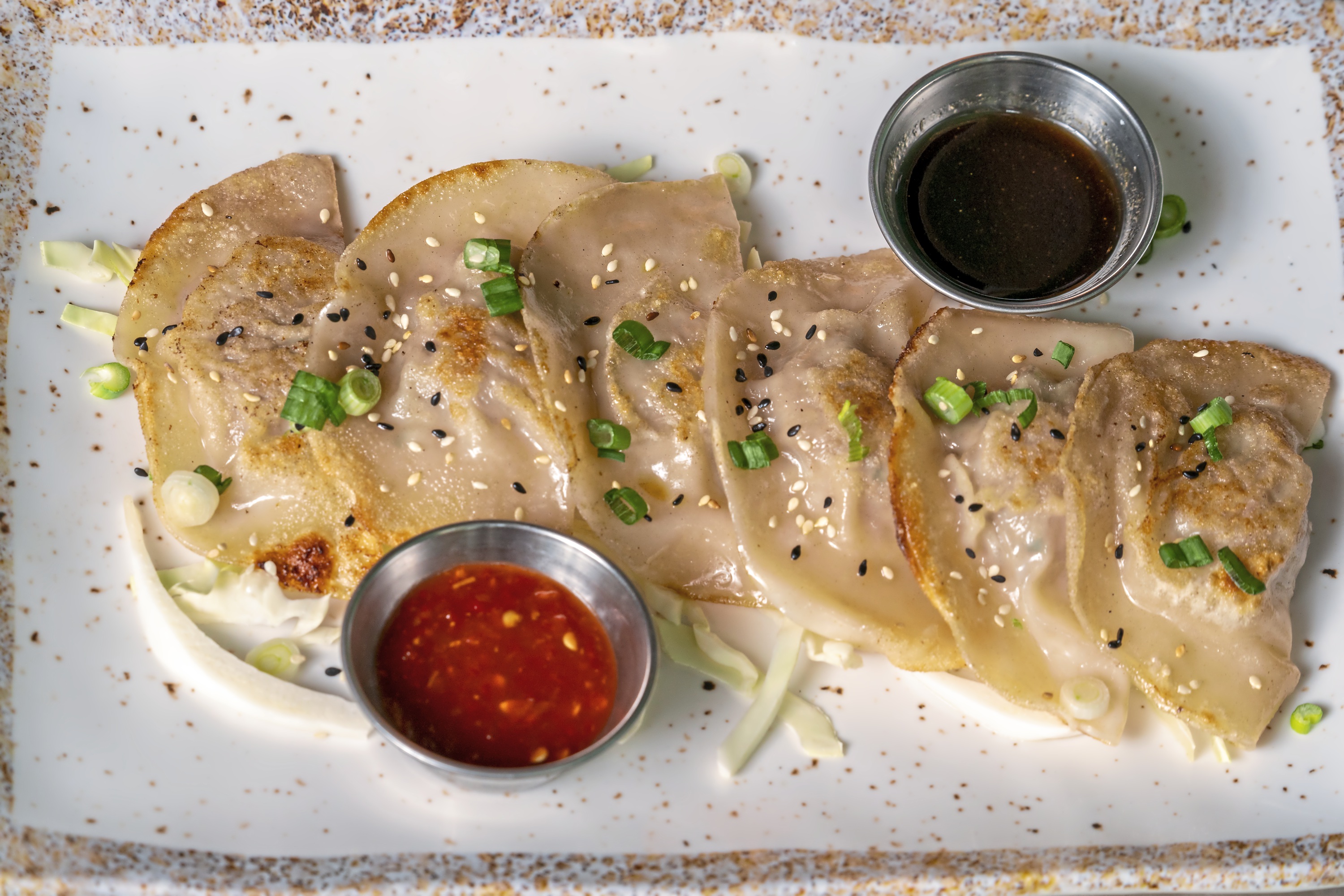
LOADING


Pittsburgh experienced a significant culinary transformation in 1983.
That year, Kiku, Pittsburgh’s first Japanese restaurant, opened in Station Square; Thai House, Pittsburgh’s first Thai restaurant, opened in Oakland; and Kim’s Coffee Shop, new in Garfield, became what was likely the first Vietnamese restaurant in the city.
Three years later, in 1986, the Strip District grocery owner Sam Bok opened the city’s first Korean restaurant, a fusion concept on Main Street in Bloomfield called Young Bin Kwan, marking another milestone in Pittsburgh’s growing Asian culinary landscape.
Although dumplings in Korean, Thai, Japanese, and Vietnamese foodways don’t play the same starring role in Pittsburgh restaurants as Chinese, Italian or Eastern European dumplings, they help tell the story of the people who run them.

“Every family has their own story to tell in terms of dumplings. It’s a love letter to the next generation,” says Edward Lai, co-owner and chef of Bae Bae’s Kitchen.
All of these countries inherited their dumplings from Chinese kitchens, yet versatility and personalization are more common as each culinary culture adapts its recipes to the ingredients of its foodways and the traditions of its families.
Lai serves handmade chicken and pork dumplings that are made from scratch from wrapper to filling, at his Downtown Korean restaurant, which opened in 2017.
“We can’t cut corners at the restaurant because this is what I’ve been doing since I was a kid,” he says. “We make them the same way my family made them. I get to pass that knowledge along to the people [who] work in the kitchen at the restaurant.”
Restaurants serving our favorite East/Southeast Asian dumplingsHow to make East or Southeast Asian dumplings at home

Korean dumplings are poised for a moment in Pittsburgh. Some of the city’s most experienced and ambitious chefs are offering their takes on mandu, the signature dumpling of the peninsula.
“The big difference between Korean and Chinese dumplings are the fillings,” says Seok Kun Han, co-chef and co-owner of Korea Garden 2. “We have more complex fillings in Korea.”
Korean dumplings offer individual spins and often use a blend of meats (beef, chicken and pork are all common) with vegetables, aromatics, tofu and even noodles. Mandu is almost always steamed first, with an optional flourish of pan-frying to finish.
Han started making dumplings 55 years ago when he was 14 and working in a Korean-Chinese restaurant in Korea. He became the breadwinner for his family after the untimely passing of his father.
He and his wife, Mun Ja Han, operated their first iteration of Korea Garden in Oakland before moving their operation to Novo Asian Food Hall in the Strip earlier this year.
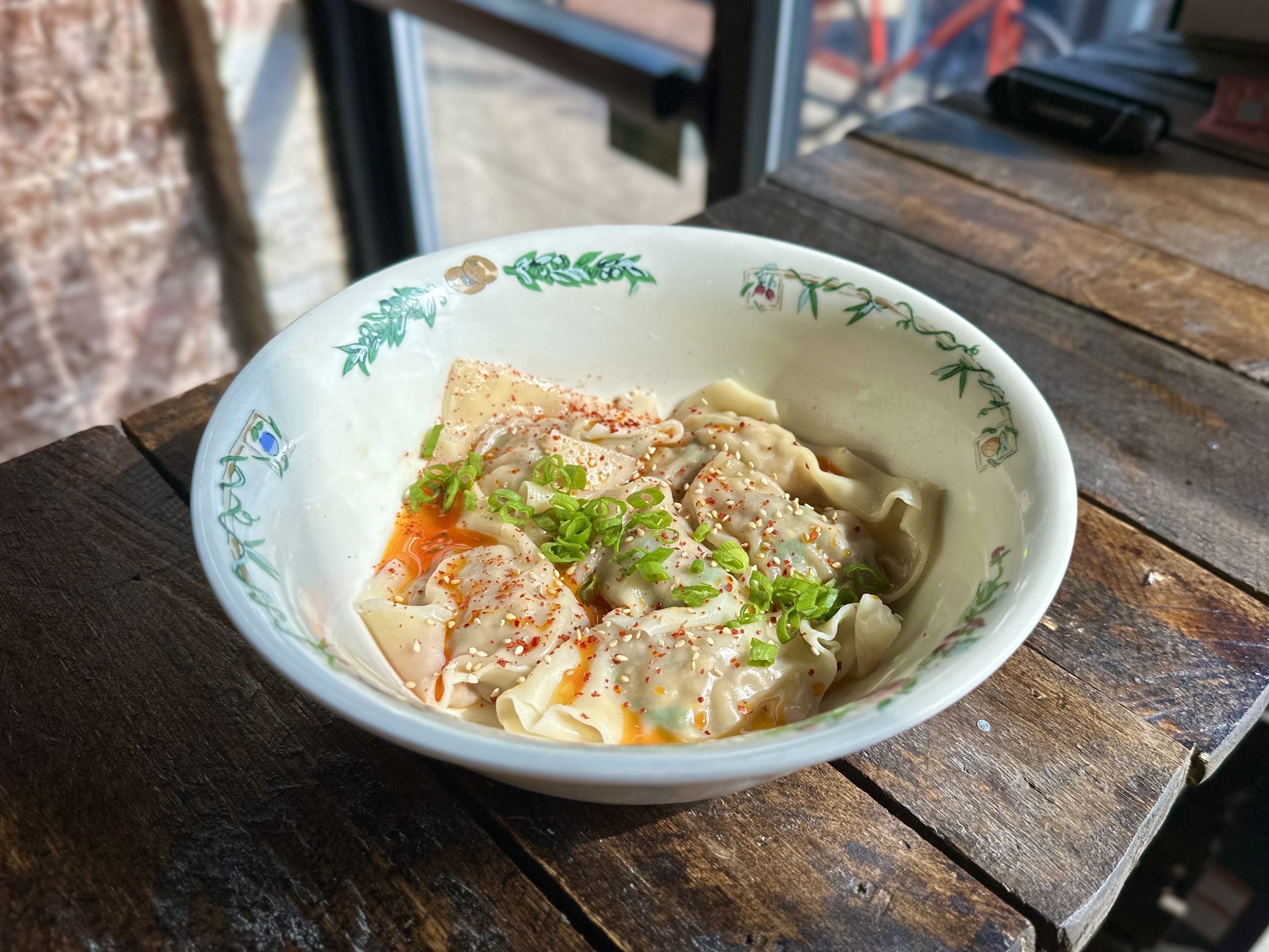
The history of mandu remains somewhat obscure, yet it is widely acknowledged that their introduction occurred during the 14th century by the Mongol-Chinese Yuan dynasty. This was particularly notable because Korea’s then-ruling Goryeo dynasty followed Buddhist principles that forbade meat consumption.
Dumplings provided a gateway into meaty indulgence, if only for a select few.
“There used to be kings and queens in Korea, and it was originally a food for them. Commoners didn’t eat dumplings because it wasn’t something they could afford,” Han says.
Today, mandu are an affordable treat everyone can enjoy. Han says they’re typically prepared in home kitchens for holidays and celebrations, like marking a child’s first birthday.
Those memories are carried by Korean American chefs such as Lai and Simon Chough, owner of Soju in Garfield.
“This is my connection to family history. We’d make food all day with my grandma and my aunt Mary, folding mandu when we were kids,” he says. “Some of my fondest memories are from those gatherings.”
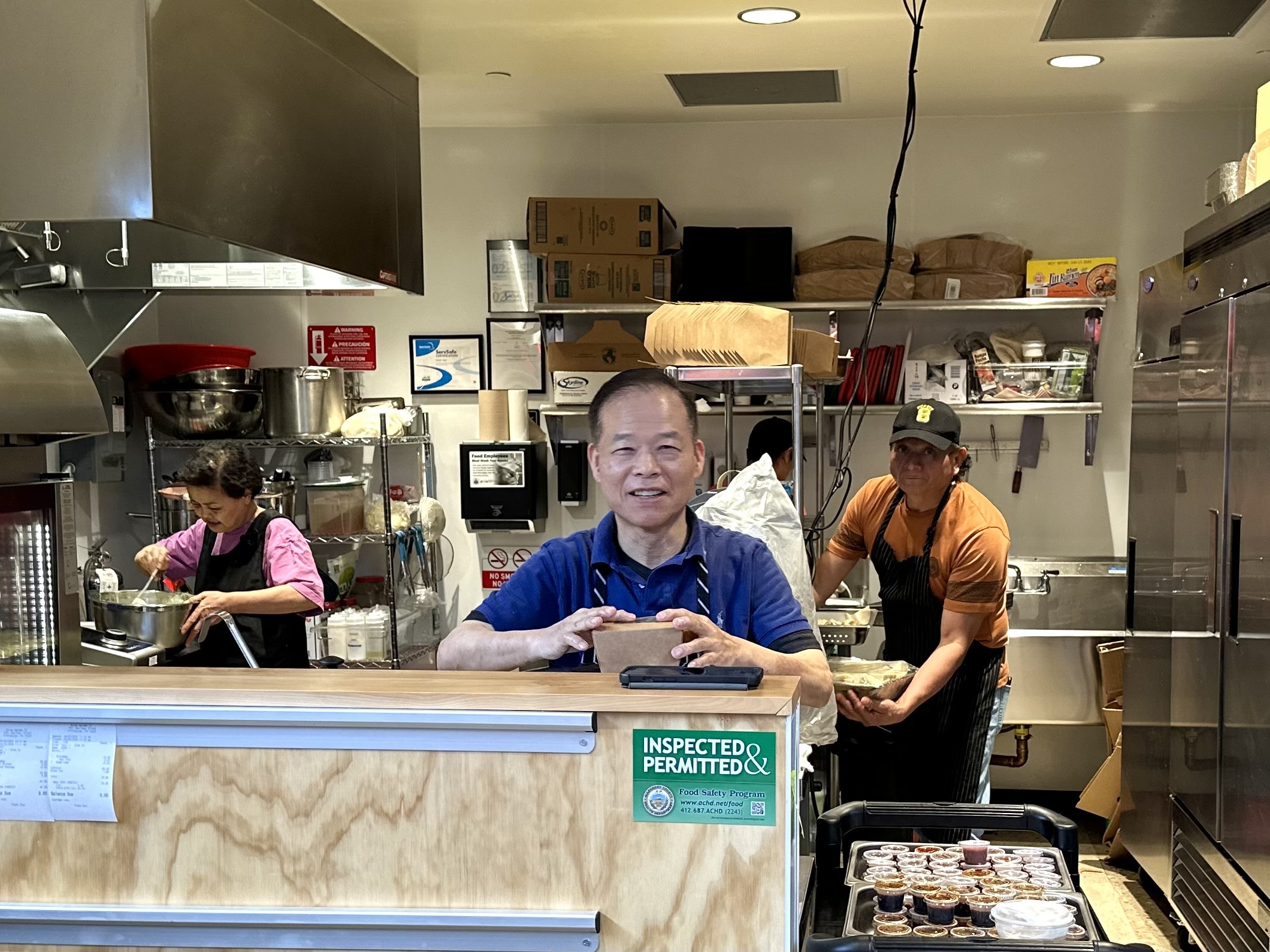

Chough’s mandu process is labor intensive. Doing the small things every step of the way — making sure all the water is rendered from vegetables like cabbage so the wrapper can form a cohesive bond with the fillings, for example — makes a massive difference in the final product.
He typically makes them once a week for the restaurant, though he aims to scale up production a bit more because of the comfort and joy they provide his customers.
As he did with his 2023 soup project, Chough uses mandu filling to explore his roots. A recent iteration on the Soju menu saw foraged Western Pennsylvania ramps and morel mushrooms mixed with a blend of pork, beef, kimchi, tofu, ginger, garlic and sesame oil packed into delicate wrappers. The plate was finished with scallion oil, chili oil, green onions and sesame seeds.
“Soju isn’t a traditional Korean restaurant. It’s a representation of who I am. As with the cuisine’s fluidity, my family recipes have evolved with years in the United States. It grants me freedom to connect my background to the food I’m serving at the restaurant.”
Once again, royal courts played a role in introducing dumpling culture to Thailand. Cho muang, for example, is a fanciful, flower-shaped dumpling with a wrapper made with various starches dyed into a soft blue with pea flowers and lime.
Royal Thai cuisine isn’t represented in Pittsburgh (head to Kalaya in Philadelphia). Here, you’ll typically find a different type of dumpling with a more direct Chinese heritage — siu mai. These delicate dumplings with an egg-and-wheat wrapper in Cantonese style are left slightly open at the top and usually decorated with fish roe. The filling is commonly made with pork, shrimp or a combination.
Nathanan “Natalie” Manjeen, owner of Took Took 98, offers another Thai dumpling at her street-food restaurant in Squirrel Hill: gu chai. Here, the skin is made from a mix of glutinous rice, wheat and tapioca flours. Its filling is straightforward: hyper-aromatic chopped Chinese chives. The wrapper is crimped around the chives in a style similar to xiao long bao and then pressed to form a patty. It’s steamed and then pan-fried, offering a crisp, chewy texture with a pungent filling.
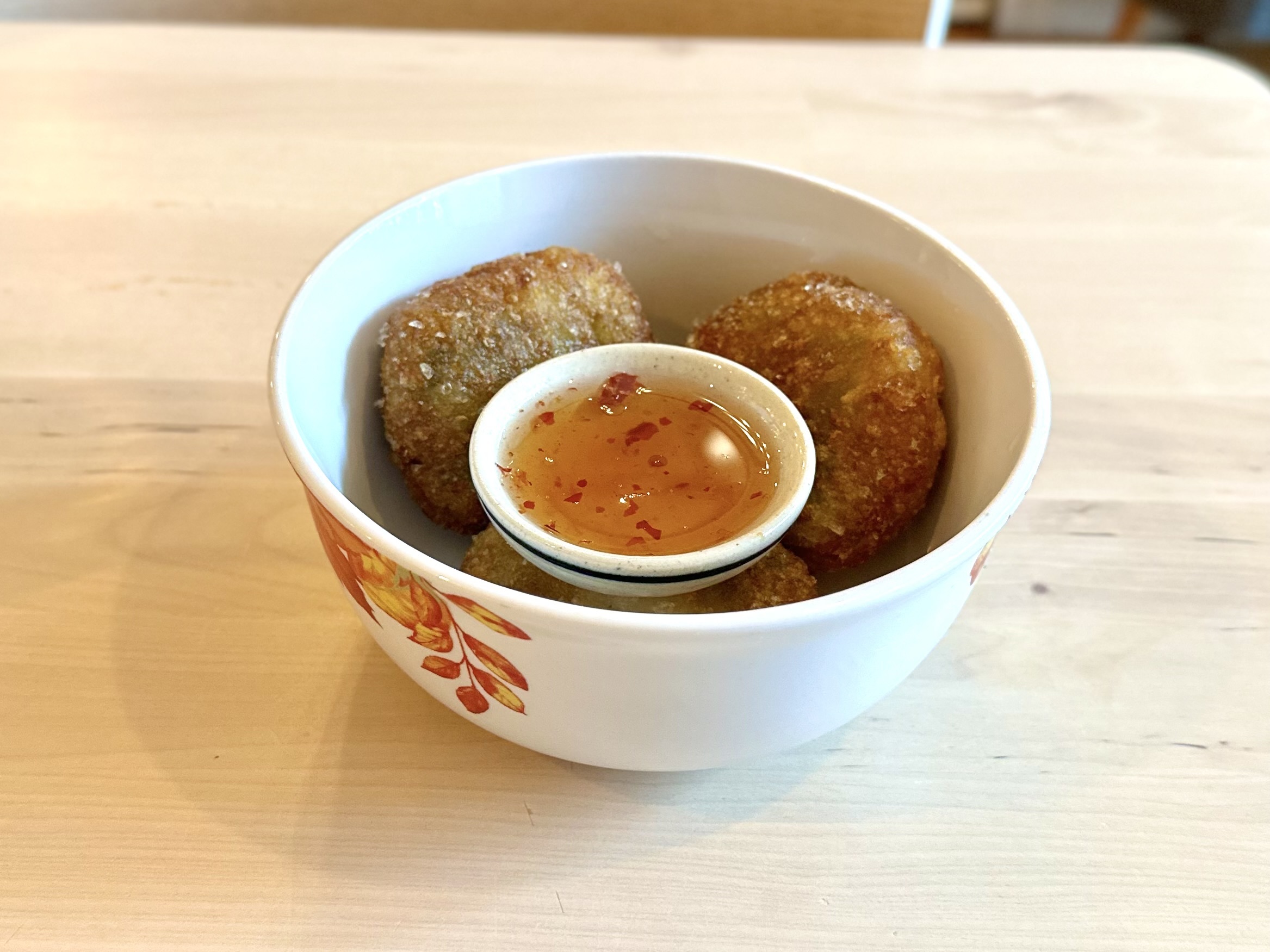
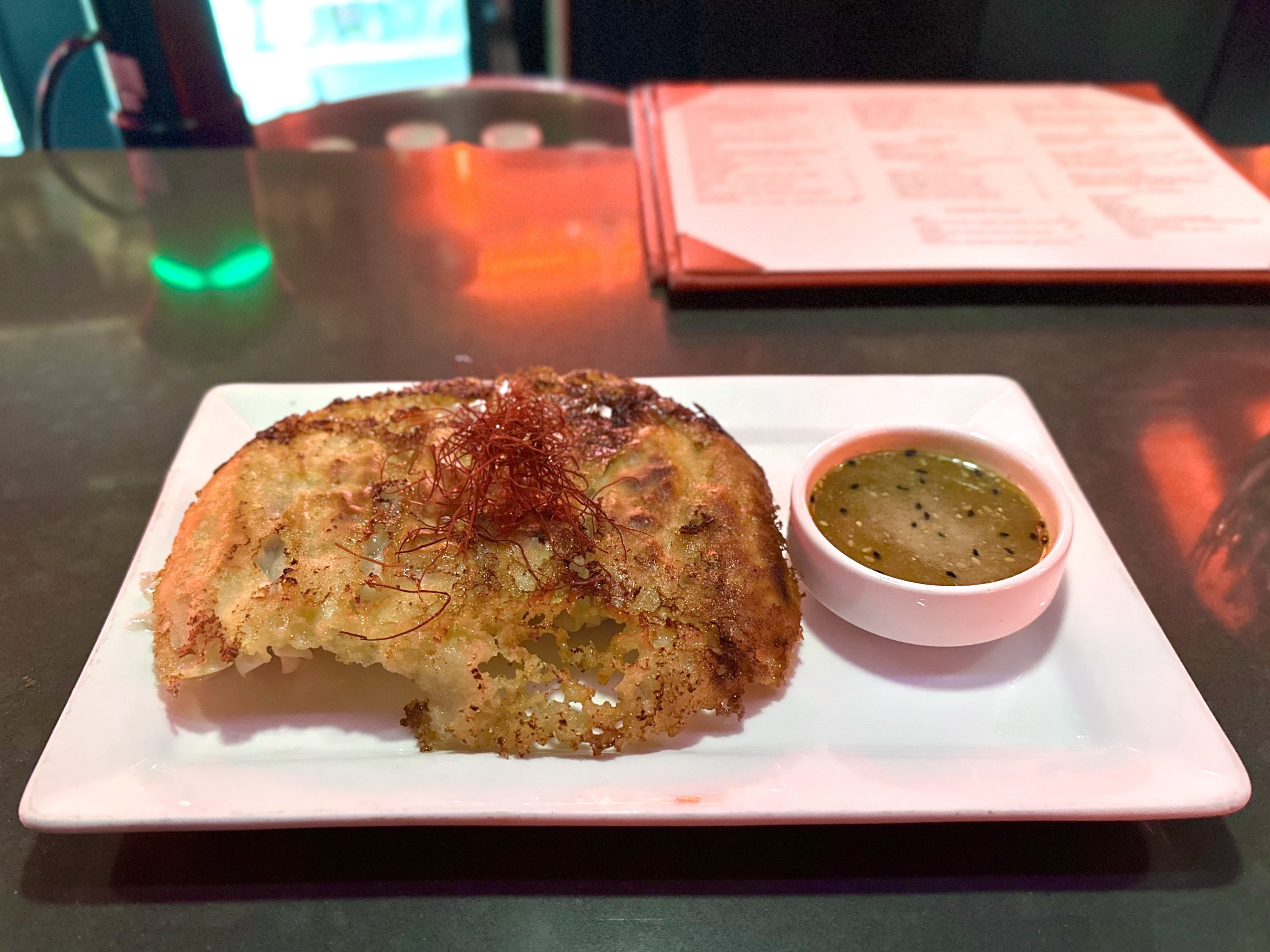
“You’ll find dumplings everywhere at street food markets. That’s where we eat most of them in Thailand. Street food at every corner, just like you’d see with Starbucks here,” Manjeen says. “My idea was to bring that culture to Pittsburgh.”
Gyoza — which gets its name from Chinese jiaozi — is Japan’s national dumpling. They don’t yet have the same impact on menus in Pittsburgh.
Roger Li, owner of Umami Izakaya in Lawrenceville, believes that’s because modern gyoza, those of the post-World War II era, are a specialty item found in homes or at shops dedicated to the craft of making them.
“In Japan, you go to a shop and all they do is gyoza. People will line up for them,” he says.
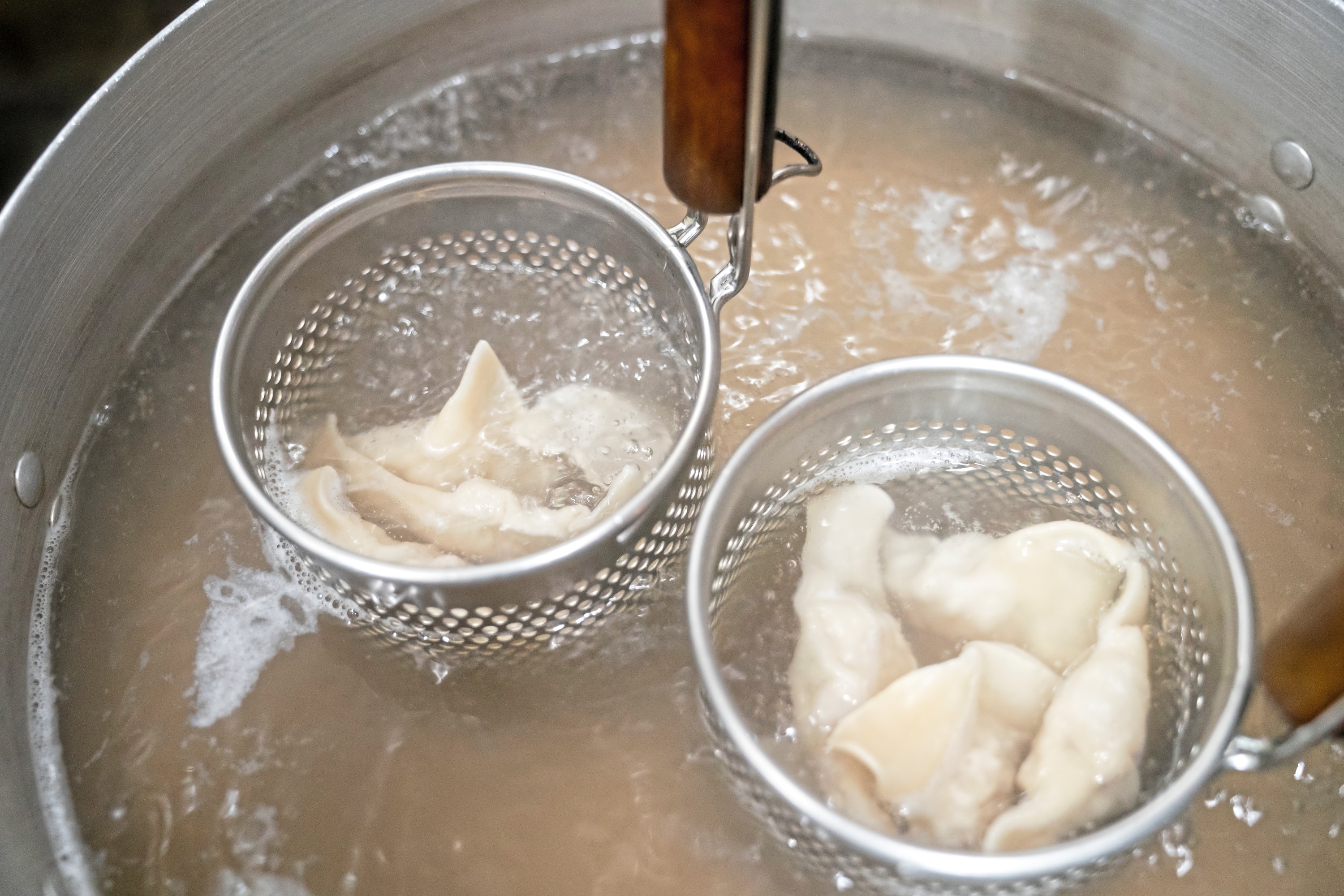
In Pittsburgh, they’re often added as a filler item to a more lengthy menu that incorporates various styles of Japanese restaurants into one catch-all establishment.
“People go to them because they understand it. It’s a good seller,” he says. “But these are usually the easy, reheated gyoza that comes to the table quickly.”
Dumplings have a long history in Japan, but their popularity and current preparation are relatively recent. According to the Japanese Culinary Institute, yaki-gyoza, the technique of steaming and frying in the same pan using starchy water and oil, became favored when a Japanese soldier returned to his hometown in Japan from China after World War II.
“That’s how you get the crispy bottoms and soft, tender tops. This method cooks everything the way it needs to be,” Li says.
Gyoza skins are crispy and delicate at the same time. Common ingredients are chopped pork (typically belly and loin), cabbage, ginger root, garlic chive, celery, scallion, shiitake mushroom and Shaoxing wine.
“Another important thing is that the dipping sauce doesn’t overwhelm the filling,” Li says.
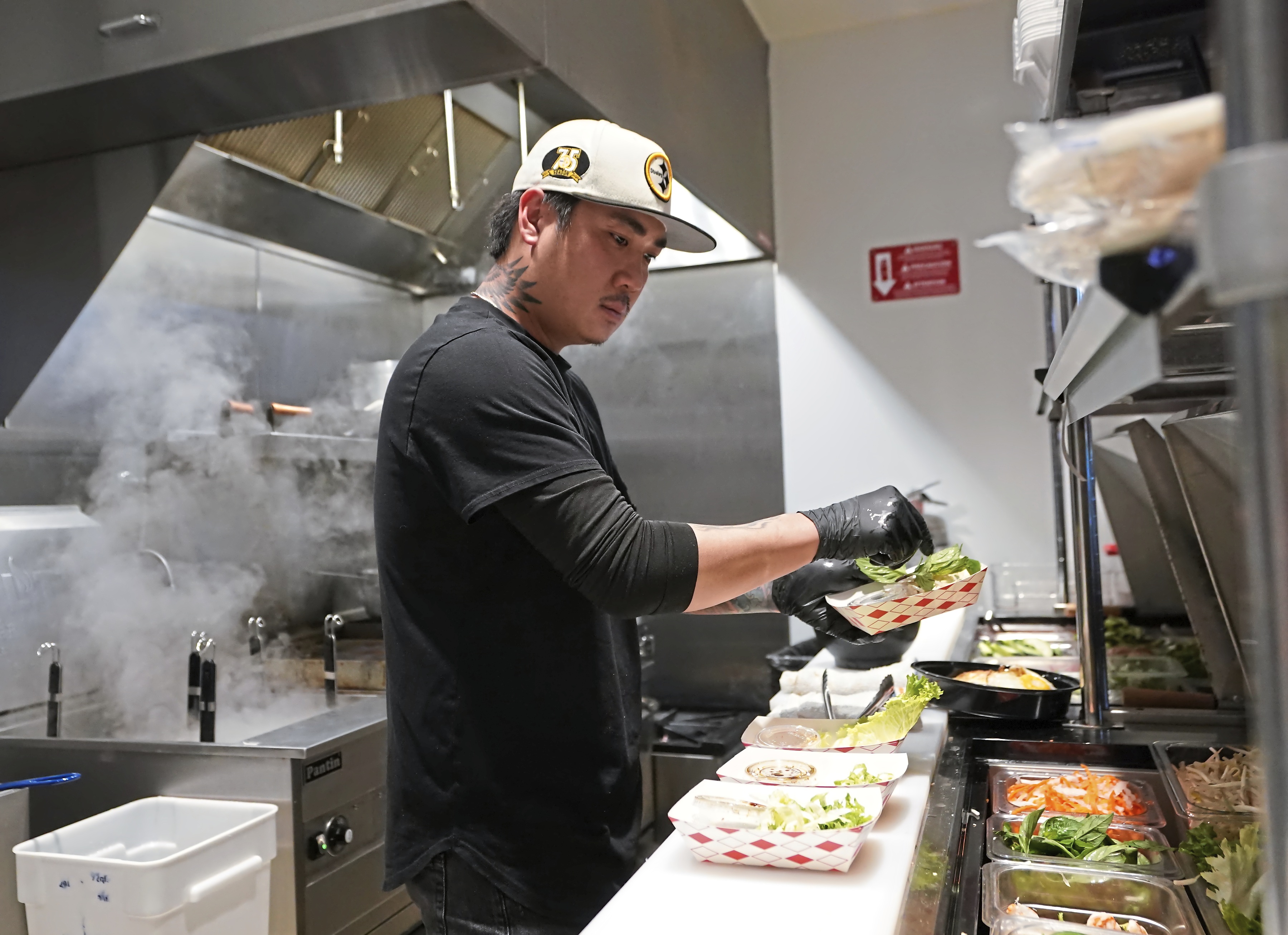
Vietnamese dumplings have the most potential for growth in Pittsburgh. The best ones in Pittsburgh are now served at Tan Lac Vien 2.
“This is my spin on dumpling culture. We have dumplings in Vietnam, but they aren’t as popular as they are in other Asian countries,” says Minh Luong, chef and owner of Tan Lac Vien, in Squirrel Hill, and Tan Lac Vien 2, at Novo Asian Food Hall.
Luong came to Pittsburgh from New York in 2012 to work at Tan Lac Vien. He purchased the restaurant from its original owners, Thy and Steve Ngo, in 2017. Eventually, he added a dumpling with supple wheat-based skin and a filling with chicken, lemongrass, ginger and a few other ingredients.
He says he was inspired by Steve Ngo’s Chinese-Vietnamese heritage to look into how he could offer a twist on Vietnamese-style dumplings, which typically have a rice- or tapioca-starch wrapper.
Minh Luong’s fusion approach celebrates the growing diversity of Pittsburgh’s Asian culinary offerings and symbolizes a bridge between traditions, old and new.

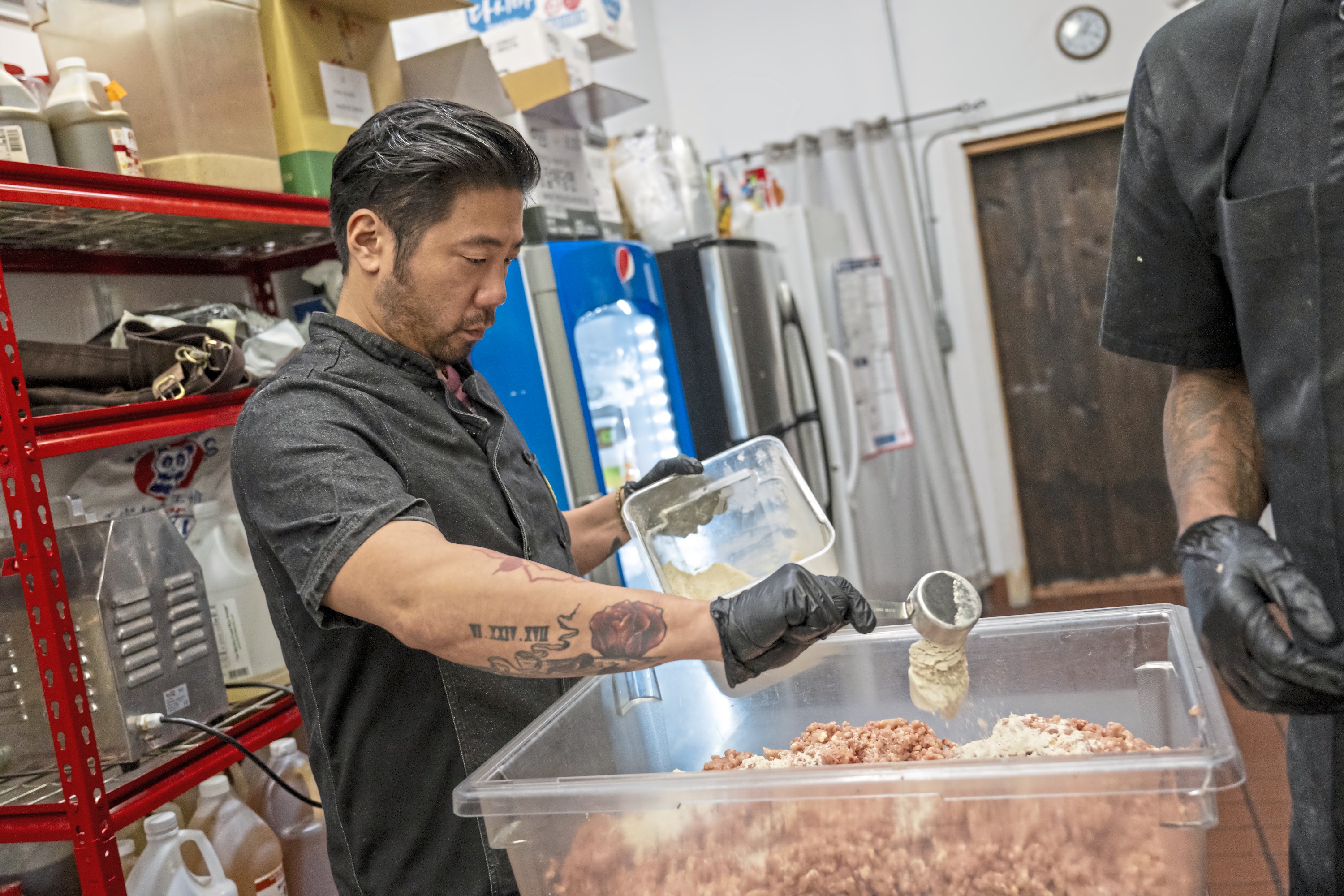
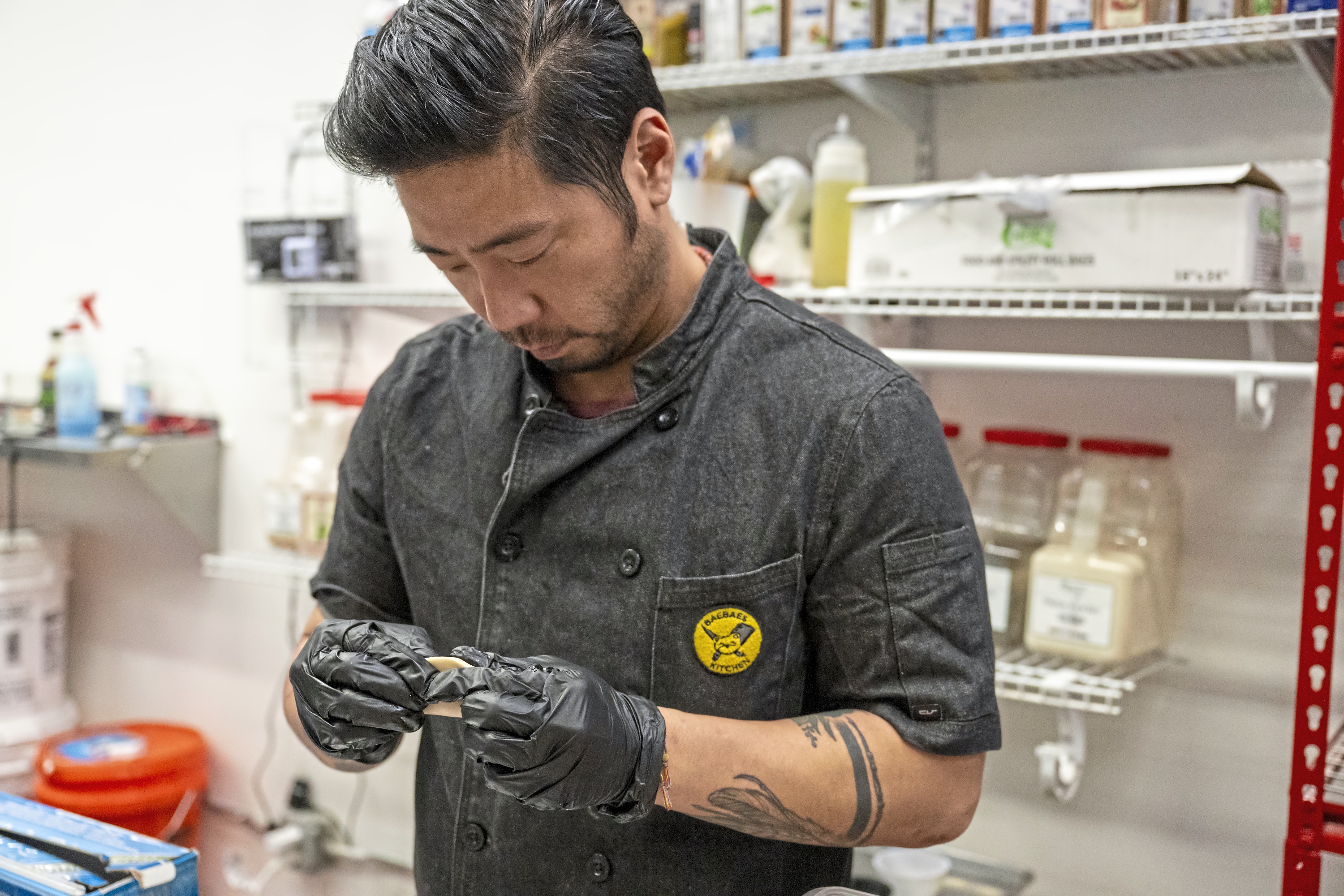
“I offered it as a chef’s special. It was something I wanted to do because of how much I love to cook,” he explains.
His passion for blending culinary cultures mirrors the city’s evolving palette, which has come a long way since those first openings in 1983. As diverse cultures continue to shape Pittsburgh’s dining landscape, the personalization of Korean, Thai, Japanese and Vietnamese dumplings offers a delightful gateway into expanding palates across generations.
This sentiment of passion and heritage is echoed by Lai of Bae Bae’s Kitchen, who sees dumplings as carriers of culture and comfort.
“It’s the very definition of comfort food,” he says. “You don’t have to think too hard about it. It’s good, it’s nutritious and it comes from the heart.”
Hal B. Klein: hklein@post-gazette.com
Where to eat East and Southeast Asian dumplings in Pittsburgh
Did somebody say dumpling road trip? Tasty Korean, Thai, Vietnamese and Japanese dumplings can be found all over the region.
Buckle up, hop on your bike, grab a friend or two and get eating. We recommend the following:
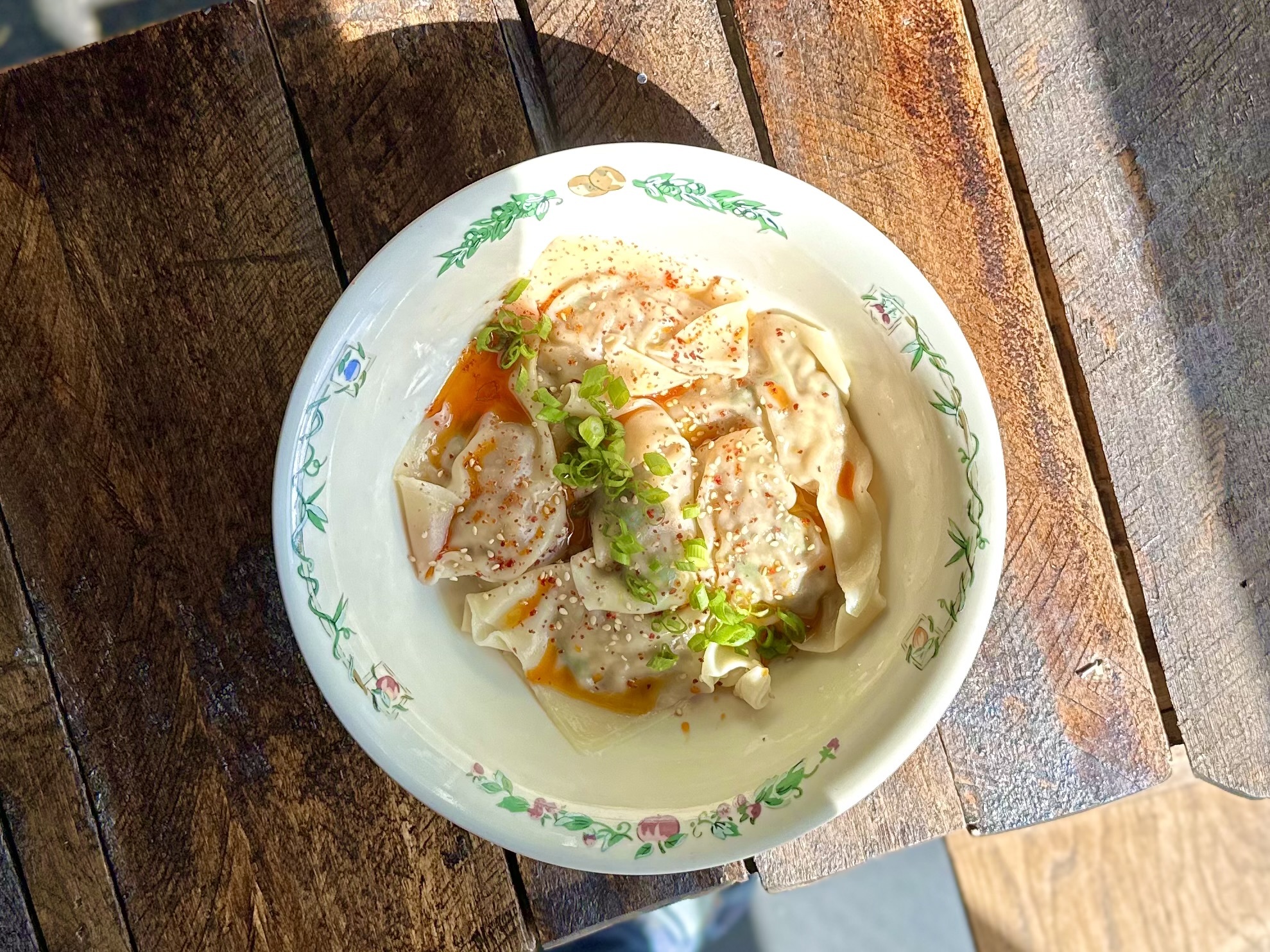
Soju (Korean)
Chef/owner Simon Chough’s mandu are an exquisite expression of his Korean American heritage. He tends to offer the from scratch dumplings at his Garfield restaurant once or twice a week, so be sure to jump on them if they’re on the menu when you visit (and check Soju’s social media to see when he’s serving). His dumplings have a silky skin filled with a dynamic blend of ingredients and toppings. An April iteration included a mixture of pork, beef, kimchi and tofu perfumed with aromatics and garnished with scallion oil, chili oil, green onions and sesame seeds.
4923 Penn Ave., Garfield; simonchough.wixsite.com/sojupgh
Umami Izakaya (Japanese)
The preparation time for the gyoza at Umami is a little longer than at other Japanese restaurants in Pittsburgh, as the dumplings are cooked to order in a single pan in the post-World War II style. The wait at this third-floor Lower Lawrenceville izakaya pays off with a plate filled with wrappers that express a duality of shatteringly crunchy and pillowy, and are stuffed with a juicy, garlicky pork filling. The accompanying rayu shoyu dipping sauce and chili threads add an extra oomph of umami and soft heat to each bite.
202 38th St., 3rd floor, Lower Lawrenceville; umamipgh.com
Took Took 98 (Thai)
Nathanan “Natalie” Manjeen offers a lens into Thai street food at her charming Squirrel Hill restaurant. Go for gu chai, a Thai favorite that’s hard to find in Pittsburgh. The crispy, chewy wrapper is prepared with glutinous rice, wheat and tapioca flours. It’s filled with pungent Chinese chives, crimped in a style similar to xiao long bao, and then pressed to form a patty. The steamed and pan-fried dumplings are a study of texture and flavor, given an additional boost with a sweet chili dipping sauce. The dumplings listed as “dumplings” are Manjeen’s spin on siu mai but with a folded top like an envelope to enclose the family recipe blend of pork, egg, scallions, onions and chestnuts.
2018 Murray Ave., Squirrel Hill; tooktook98.com
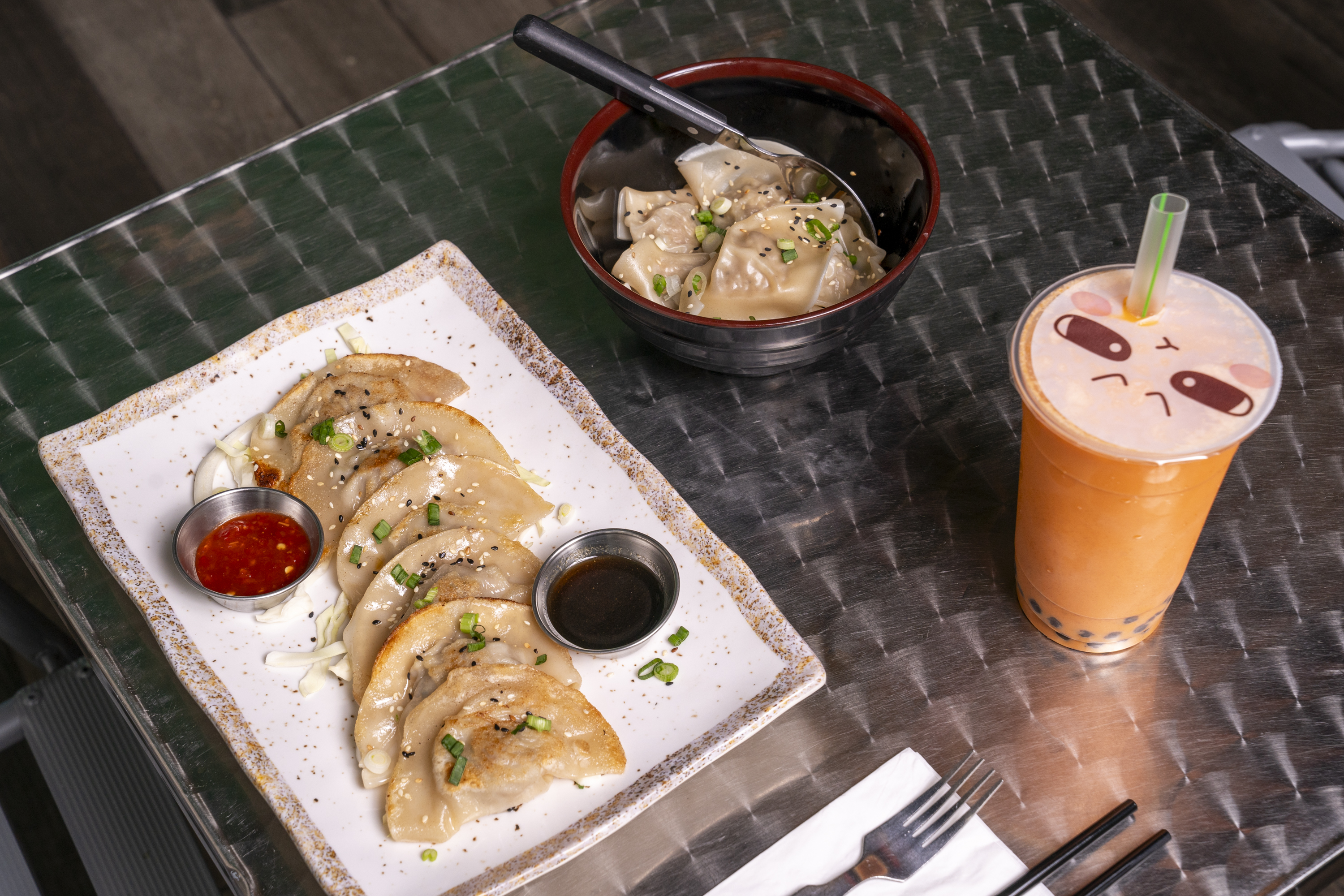
Bae Bae’s Kitchen (Korean)
Handmade every step of the way is the key to the gorgeous mandu served at Bae Bae’s Kitchen. The Downtown restaurant offers chicken and pork dumplings, both mixed with cabbage and green onions. You can get them pan-fried, which adds a nice crispness, but experiencing the supple texture of the steamed version is a real treat. A sprinkle of toasted sesame seeds added as a finishing flourish heightens the depth of flavor of these edible memories of co-owner Edward Lai’s childhood.
951 Liberty Ave., Downtown; baebaes.kitchen
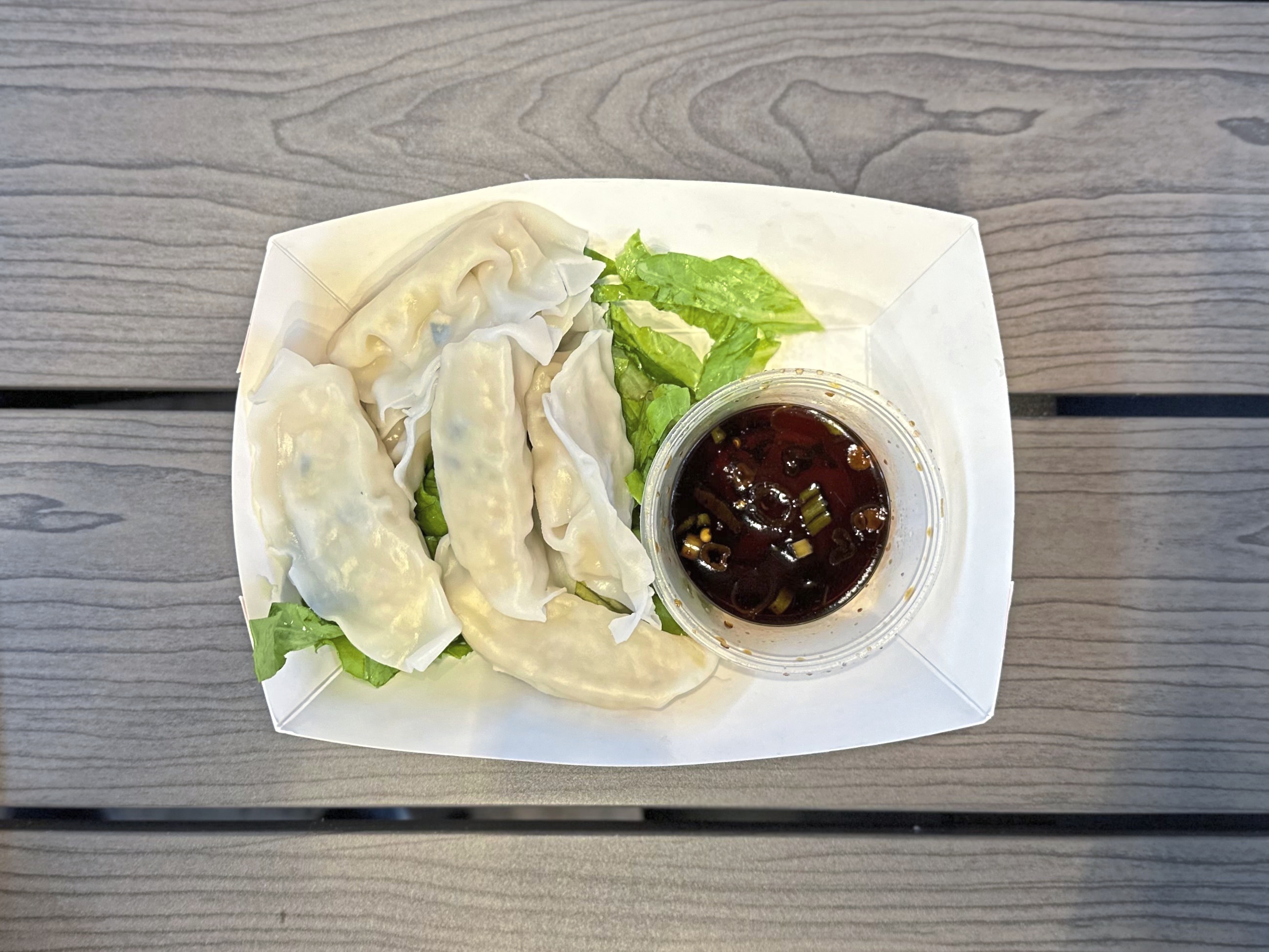
Tan Lac Vien (Vietnamese)
Minh Luong, chef and owner of Tan Lac Vien, offers a Vietnamese spin on Chinese dumplings at his Squirrel Hill and Strip District establishments. The Saigon native, who grew up in Orange County, Calif., spent months working on a recipe that would pay homage to his roots and multifaceted culinary training. His cushiony dumpling skins turn breathtakingly tender when he steams them. Those wrappers envelop a finely chopped chicken stuffing; the combination translates to sublime texture and fragrance in each juicy bite.
2114 Murray Ave., Squirrel Hill (Tan Lac Vien Bistro)
1931 Smallman St., Strip District (Tan Lac Vien 2 at Novo Asian Food Hall)
tanlacvienpgh.com
Korea Garden 2 (Korean)
As of press time, Seok Kun Han’s gorgeous dumplings are only available on weekends at his Korea Garden 2 restaurant in Novo Asian Food Hall. They’re so tasty it’s even worth making a trip to the Strip, even though it’s hectic down there on weekends, to crush an order or two of the blend of ground beef, tofu, vermicelli noodles, zucchini, onions, garlic, green onions — and a touch of sugar to balance them — stuffed inside handmade wrappers that are steamed and then pan-fried to a gorgeous golden brown.
1931 Smallman St., Strip District

PGH Dumplingz (various)
Eric White’s boundary-breaking dumplings capture the spirit of personalization. The Pittsburgh native, who once worked as an executive chef for P.F. Chang’s, blends his experience with the restaurant chain, memories of his Hill District and Sheraden childhood and his love of other Pittsburgh food businesses into mixtures for the dumplings he serves at pop-ups throughout the region. White’s website and Instagram account are the best way to find out what and where he’s serving every week.
New Saigon (Vietnamese)
Fried chicken dumplings are packed with springy ground chicken and aromatic lemongrass. They’re cooked to a tender-crunchy texture comparable to a pot sticker. Drench them in the soy-based dipping sauce, which is savory and herbaceous and has a soft, building heat on the back end.
1429 Potomac Ave., Dormont; saigonpgh.com
Smiling Banana Leaf (Thai)
Paper-thin wrappers with delicate crimping in the sui mai-style form a delicate shell encasing a luscious mix of pork and onion. The dumplings at the Highland Park restaurant are served with a tangy-sweet chili sauce.
5901 Bryant St., Highland Park; smilingbananaleaf.com
Oishii Donburi (Japanese)
Listed on the menu as kyoza, the fried dumplings at this Upper Lawrenceville spot hit the nexus of crispy and juicy better than most in Pittsburgh. The filling combines chicken and pork, boosted by ginger and garlic. Let them cool for a minute before popping these delightful bites into the vibrant dipping sauce.
5227 Butler St., Upper Lawrenceville; oishiidonburi.com
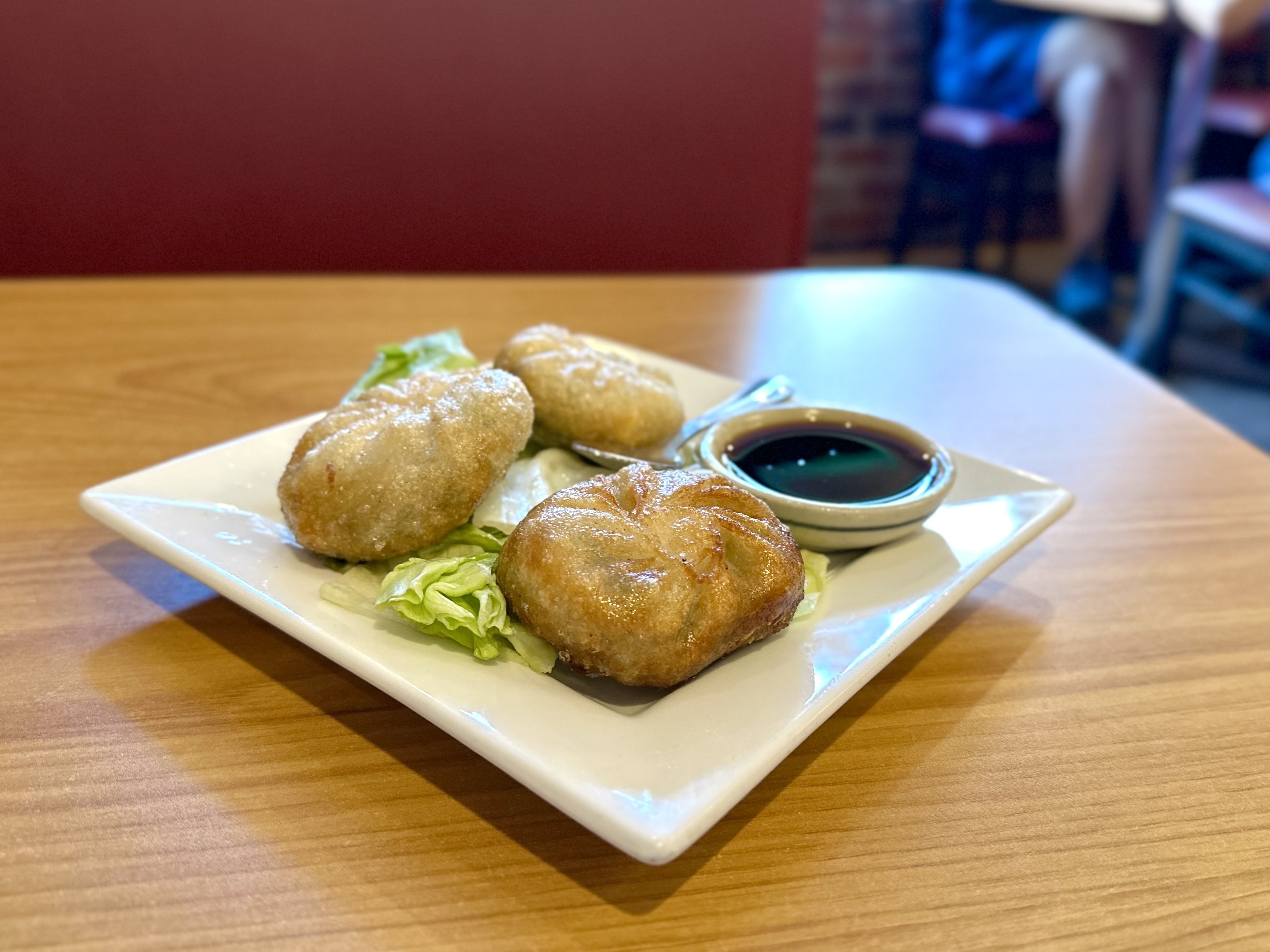
Ocha Thai Noodle Restaurant (Thai)
Ocha Thai in South Oakland is Pittsburgh’s destination restaurant for late-night dumplings. The pocket-sized BYOB is open until 1:30 a.m. on weeknights and 2:30 a.m. on weekends. Get the crackly, chewy gu chai with a deep allium aroma from its garlic chives. Handmade pork and chicken dumplings are another good option, enchanted with crispy fried garlic slivers and a tangy side sauce. The restaurant also offers steamed pork pot stickers.
422 Semple St., South Oakland; ochathainoodlepa.com
Nak Won Garden (Korean)
Nak Won Garden’s mandu — listed on the menu simply as “dumplings” — are filled with pork and beef and have a soft, fragrant aroma. Served steamed, they have a nearly melting texture. I popped a few of mine into a boiling bowl of kimchi jjigae, where they melded with the tart heat of the stew. Pan-fried, the dumplings served in Nak Won Garden’s homey dining room are crispy comfort food.
5504 Centre Ave., Shadyside; instagram.com/nakwongarden_pgh
Kiku (Japanese)
Pittsburgh’s oldest Japanese restaurant keeps it simple with the gyoza prepared in the Station Square establishment’s hot kitchen. Thin wrappers are stuffed with a bouncy chicken stuffing, steamed to tenderness and given a quick fry that offers a bit of extra umami from a slight char.
225 W. Station Square Drive, South Shore; kikupittsburgh.net
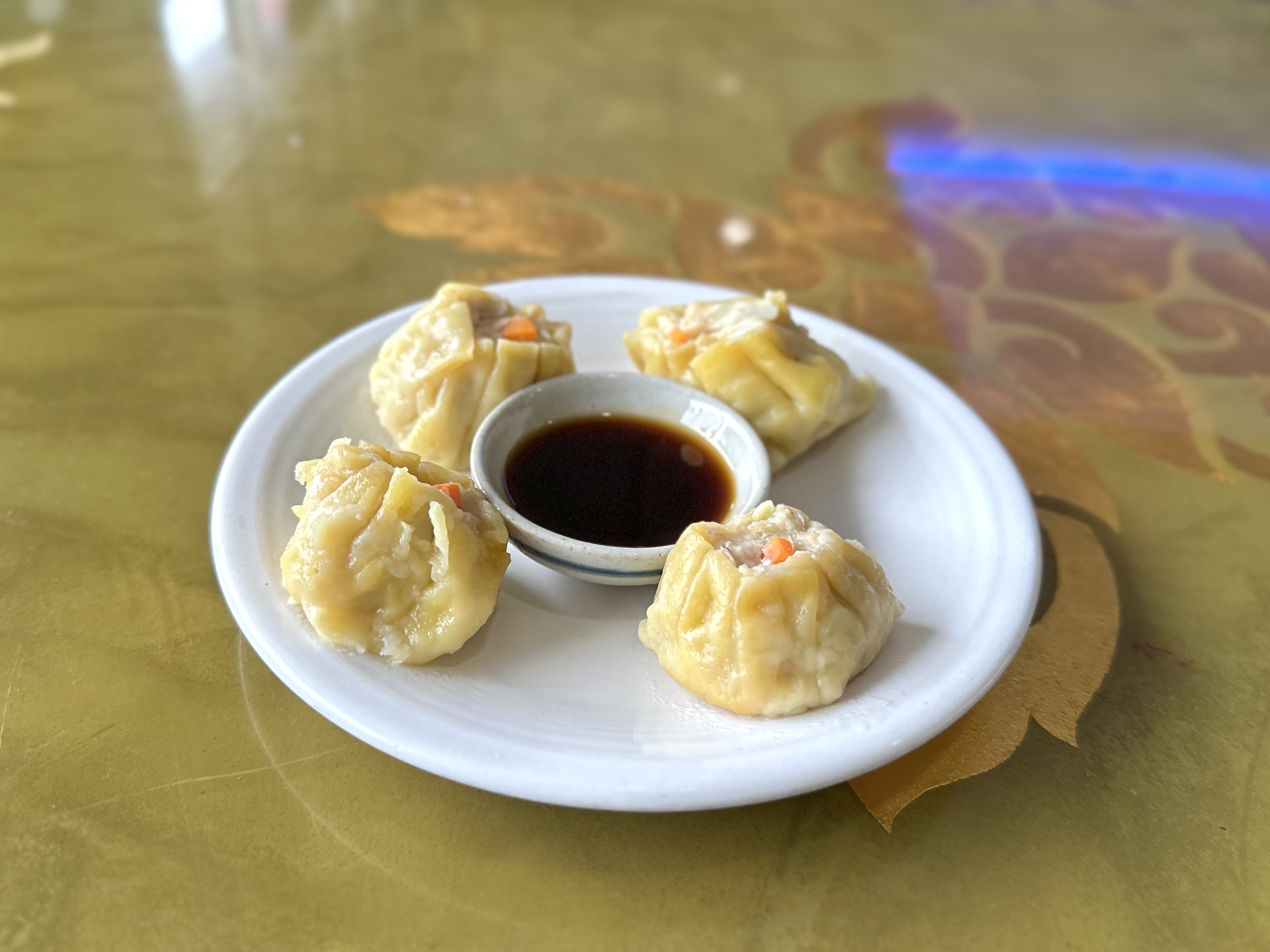
Thai Place (Thai)
Thai Place, opened in 1989, is the region’s longest-standing Thai restaurant business. Its Wexford location is the last of several restaurants with the same name operated by Santi and Surin Thamwiwat, and it’s a solid destination for Thai dumplings. Go for the steamed version, which includes chopped chicken bolstered with herbaceous celery leaves. Diced carrot replaces the more traditional fish roe atop the sui mai, adding a vegetal sweetness.
12009 Perry Highway, Pine; thaiplacepgh.com
Golden Pig (Korean)
Yong Kwon runs the region’s most charming Korean restaurant, located on a stretch of rural-industrial road in Cecil. Her homestyle menu includes a lovely rendition of mandu pan-fried on both sides to offer a crisp exterior. If you’re in the mood for something brothy, go for the mandu guk, which highlights Kwon’s dumplings in a soothing soup.
3201 Millers Run Road, Cecil; facebook.com/YongsGoldenPig
Hal B. Klein: hklein@post-gazette.com
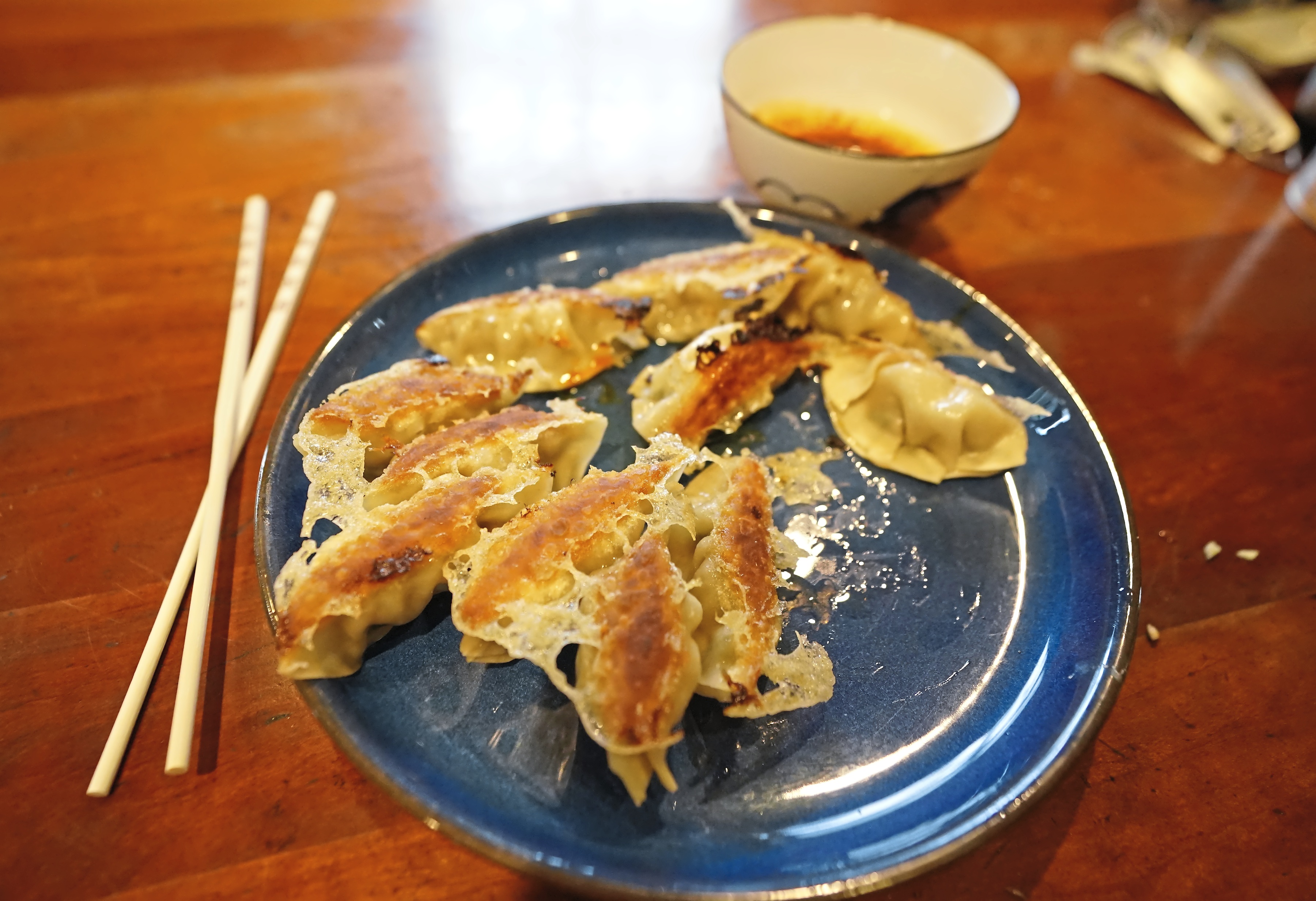
Rie McClenny grew up in southwestern Japan with family members who not only loved to cook but, as the owners of a tearoom and cafe in their small seaside city, were pretty darn good at it.
The simple, home-cooked meals her mother, Yoko, and maternal grandmother, Kiyoko, prepared for their rural customers, using seasonal local ingredients and traditional recipes, were far from fancy. Yet their skillful mix of salty, sweet, sour and bitter — key elements in authentic Japanese cuisine — were rich with umami flavor.
The women were particularly good at making one beloved Japanese comfort food: the ground pork- and cabbage-filled, pan-fried dumplings known as yaki-gyoza.
As McClenny recalls in her first cookbook “Make it Japanese” (Clarkson Potter, $30), they were absolute whizzes at folding dough wrappers around the savory filling to create tasty bundles that were juicy and tender on the inside and crispy, golden-brown on the outside. So good, in fact, that she never felt the urge to learn to make them herself.

“I enjoyed baking, and also enjoyed reading recipes in cookbooks and magazines,” she says on a call from her home in Los Angeles, “but my mom was such a great cook I didn’t feel I needed to do it.”
Instead, she watched her mom for “hours on end as she folded gyoza faster than my eyes could follow and never measured ingredients — one circular pour of soy sauce, a handful of bonito flakes, a dash of sake,” she writes in the book’s intro.
While her mom imparted a few basics before she left the house to go to university in Osaka, it wasn’t until McClenny landed in a rural town in West Virginia on a year-abroad program that she realized reading about cooking is a sad substitute for actually doing it.
Also, being away from Japan for so long made her more aware of her Japanese heritage as well as homesick for her mom’s cooking. So pulling herself up from her non-cooking bootstraps, she started re-creating those recipes — gyoza included — using a “mishmash” of three ingredients found in every Japanese pantry: soy sauce, sake and mirin.
“There was only one Asian market, so I used what was available,” she says.
She found herself compromising once again with ingredients in her chase to conjure the flavors of her childhood during a post-college job at Disney World’s Japan Pavilion in Orlando, Fla. But at least she was honing her skills as a cook, which would prove useful in her next job working for a Japanese culinary school.
When the school asked her to open a patisserie cafe in New York in 2007, it proved to be a turning point in her career. Being surrounded by ambitious people who were following their dreams, she realized it was now or never.
“I just thought the food industry was so interesting,” she says, “so I started learning more and more. Students were so passionate about restaurants and bakeries.”
At age 33, she enrolled at the French Culinary Institute (now the Institute of Culinary Education) thinking she might become a food stylist. She had so much fun and loved cooking so much that, after graduating, she became a chef instead, moving to Los Angeles with her husband to become a chef at two Santa Monica restaurants.
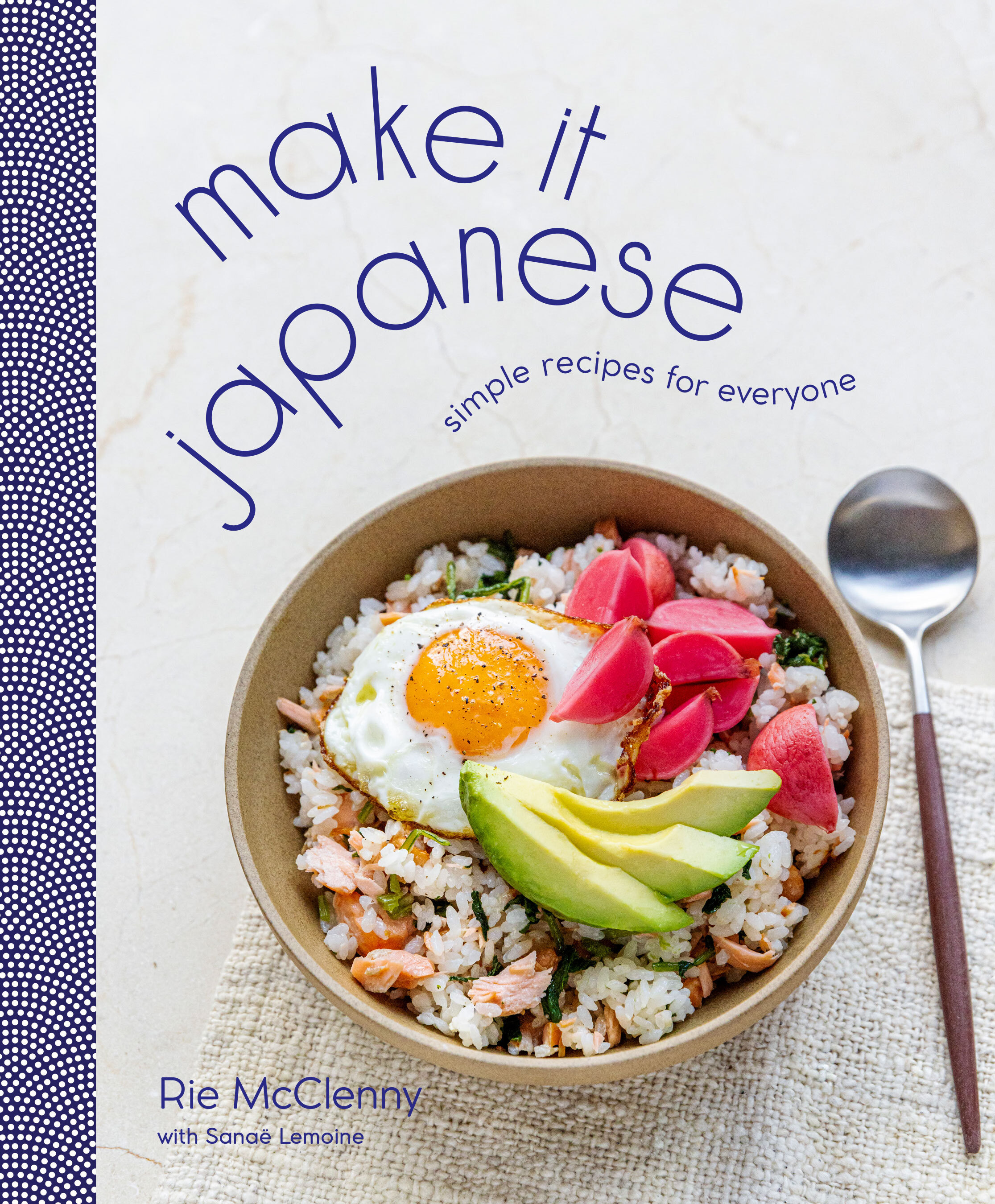
She cooked professionally for three years before burning out one night after working more than 300 meals. Deciding that a food media job would be less stressful (but still fun), in April 2016 she applied for a position as a recipe developer at Tasty Japan, the Japanese edition of BuzzFeed’s food media brand Tasty.
Three months later, she was hired as a full-time video producer and she soon was also appearing in videos on YouTube for BuzzFeed, though she admits to being very self-conscious about her English skills and Japanese accent.
“But the more I did it, the more I realized people didn’t care so much,” she says. “They just want to learn how to cook. They are not learning English from me, but Japanese culture and food from a person from Japan.”
Despite the long hours to get there, she says, “it was exhilarating to finally pursue what I loved.”
Showcasing the beauty of Japanese cuisine on camera made her realize she wanted to show that “Japanese home cooking can be for everyone.” So when a publisher reached out to her in 2021 to do a cookbook, she said yes, and started writing that same year, drawing on the nourishing food her mom cooked throughout her childhood for inspiration.
“There are a lot of Japanese cookbooks, but I wanted one [that focused] on very approachable Japanese cooking, where you can make it if you have some of the basic items,” she says of the book, which took two years to complete. As she discovered while living in West Virginia so many years ago, with salt from soy sauce, acidity from sake and sweetness from mirin, “you can basically cook anywhere.”
While some of her offerings require time, many of the dishes in “Make it Japanese” will easily come together on a busy weekend night. Most recipes are based on food she grew up eating or learned to cook once she moved to the U.S., using ingredients you can get at any Trader Joe’s or Whole Foods instead of a specialty store.
Geared to those new to Japanese cooking, the book also includes instructions on how to stock a Japanese pantry and has a short chapter on essential Japanese cooking tools.
It’s not only very traditional, she says, but demonstrates exactly how she cooks at home. That includes a step-by-step recipe for her mother’s gyoza that discloses the secret ingredient that makes them so incredibly tasty and craving inducing — nira, or garlic chives. (They’re also known as Chinese leeks.)
“You definitely don’t want to go on a date after eating them, they’re so stinky,” McClenny says with a laugh.
Eaten in Japan since ancient times, the long, grass-like blades are more pungent and garlicky than regular chives. In addition to dumplings, they’re a go-to flavor-booster for everything from soup to kimchi, stew to green onion pancakes, after trimming off the root end and white tips.
Her mom’s recipe also includes seasoning the ground pork filling with grated ginger, soy sauce and sake and adding fresh shiitake mushrooms and lots of finely chopped cabbage for a bit of silky heft. “But every home has a different recipe,” she says.
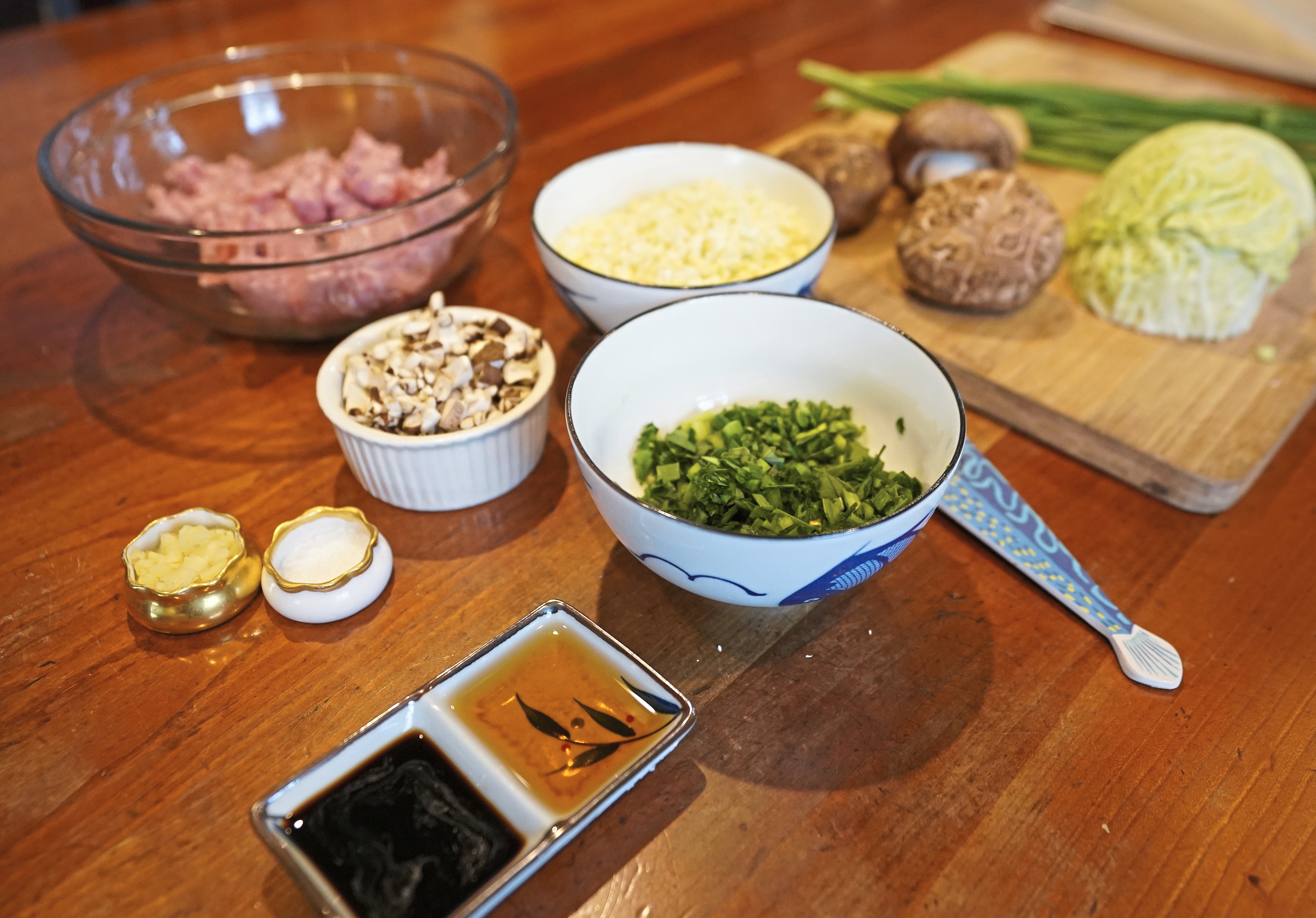
She also makes the gyoza with a lacy, crispy crust on the bottom called “wings,” or hane in Japanese — created by adding a cornstarch slurry to the pan while the dumplings are steam-frying. They’re served, with golden-brown aplomb, upside down on the plate, with a dipping sauce made from soy sauce, rice vinegar, and sesame and chili oils.
While gyoza originated in China, where they are called jiaozi, they’re actually two very different animals, says McClenny. For starters, Chinese potstickers boast a thicker dough. They’re also boiled, whereas “when we say ‘gyoza,’ we usually mean pan-fried.”
Though you can (and just might) make a meal of them, gyoza in Japan are almost always a side dish, says McClenny. They’re also almost always made with super-thin premade wrappers in Japanese homes because they’re easy to find in any grocery store. Plus, a recipe makes so many of them, and stuffing and folding the dumplings just so — gathered on one side and flat on the other — takes time. So why complicate matters by adding homemade dough to the equation?
That said, even with premade wrappers, it might take beginners a lot of practice before their fingers develop the requisite muscle memory to fill, fold and pleat at a record pace.
“But don’t stress,” says McClenny. “It’s just practice. Channel your inner grandmother or mother, try your best and, if it doesn’t look great, it still tastes good anyway.”
Her one tip is to go kind of skimpy on the filling, with less than a tablespoon. “You feel like you want to fill a lot, but if you overfill it will come out.”
Once you get the hang of it, you’ll find gyoza are incredibly fun to make, even if they’re not perfect.
“It’s just home cooking,” says McClenny. “Your family won’t judge you. They’ll be impressed you’re making [dumplings] from scratch.”
Recipe: Gyoza with Crispy ‘Wings’
PG tested
For the prettiest pleats, be careful not to overfill the wrappers. Adding a little cornstarch slurry to the pan while cooking the dumplings will create a lacy, crispy crust on the bottom called “hane” — Japanese for wings.
Unless you’re an overachiever, don’t worry about making dough from scratch for these pan-fried dumplings. Even in Japan, most home cooks use premade wrappers, which you can find in any Asian market.
Japanese gyoza are meant to be very garlicky, so if you can’t find nira chives at your local Asian market, use the same amount of scallions or chives, but also add 2 grated garlic cloves to the filling.
For dipping sauce
¼ cup soy sauce
¼ cup rice vinegar
1 tablespoon toasted sesame oil
1 teaspoon chili oil
For filling
8 ounces ground pork
1 cup finely chopped green cabbage (about 3 ounces)
¾ cup finely chopped nira chives (about 1½ ounces)
¼ cup finely chopped fresh shiitake mushrooms (about ¾ ounce)
½ teaspoon finely grated fresh ginger
1½ teaspoons soy sauce
1½ teaspoons toasted sesame oil
1½ teaspoons sake
½ teaspoon kosher salt
½ teaspoon freshly ground black pepper
For dumplings
Cornstarch or potato starch
35 to 40 gyoza wrappers
2 teaspoons neutral oil, such as canola or grapeseed
Kosher salt
Toasted sesame oil
Make dipping sauce
In small bowl, whisk together the soy sauce, vinegar, sesame oil and chili oil. The sauce will keep in an airtight container in the refrigerator for up to 3 weeks.
Make filling
In a large bowl, combine the ground pork, cabbage, nira chives, shiitake, ginger, soy sauce, sesame oil, sake, salt and pepper. Using your hands, mix well to combine.
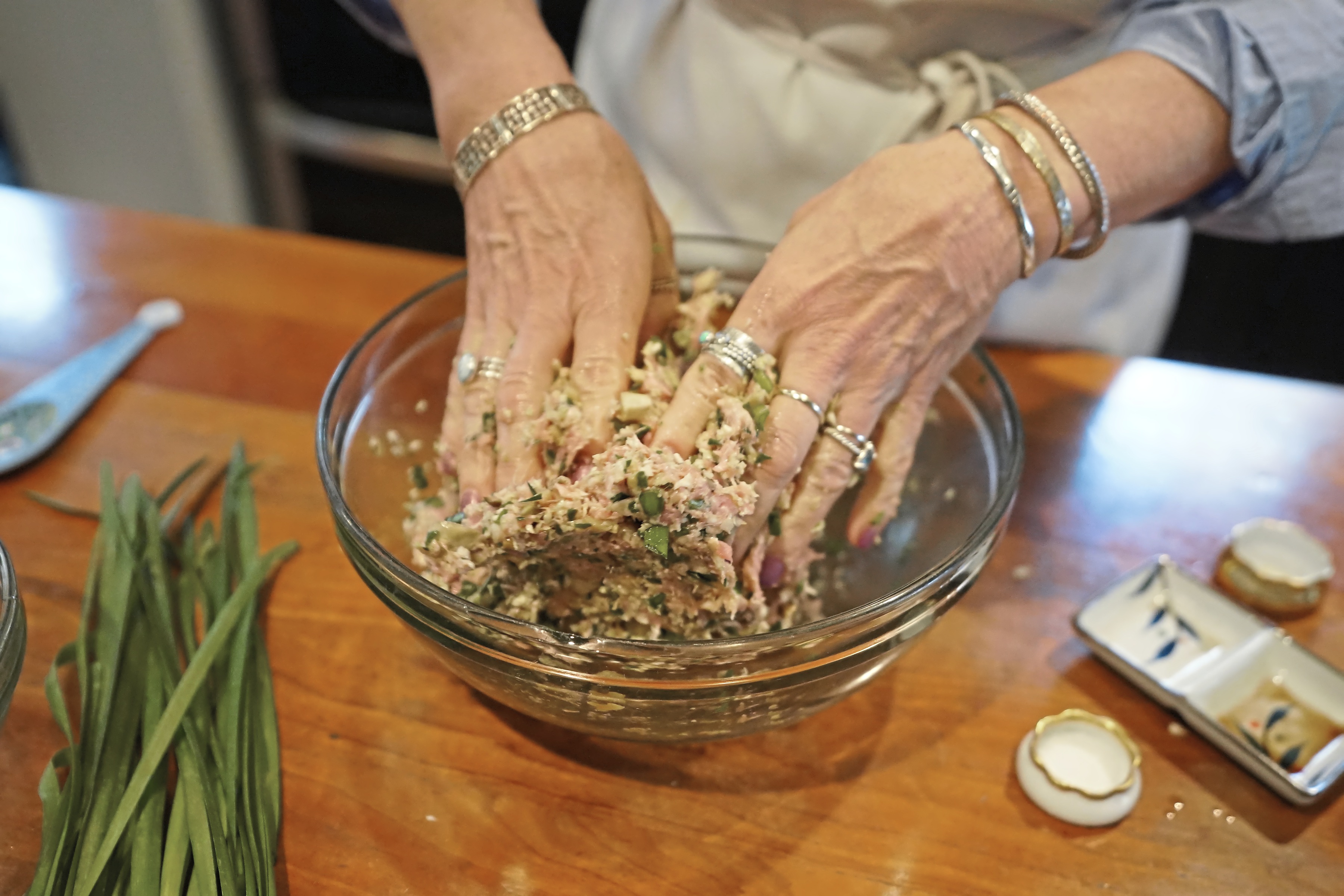
Make dumplings
Dust a baking sheet with cornstarch. Fill a small bowl with water.
Place a gyoza wrapper in the palm of your non-dominant hand. Using your dominant hand, place a scant 1 tablespoon filling in the center of the wrapper.
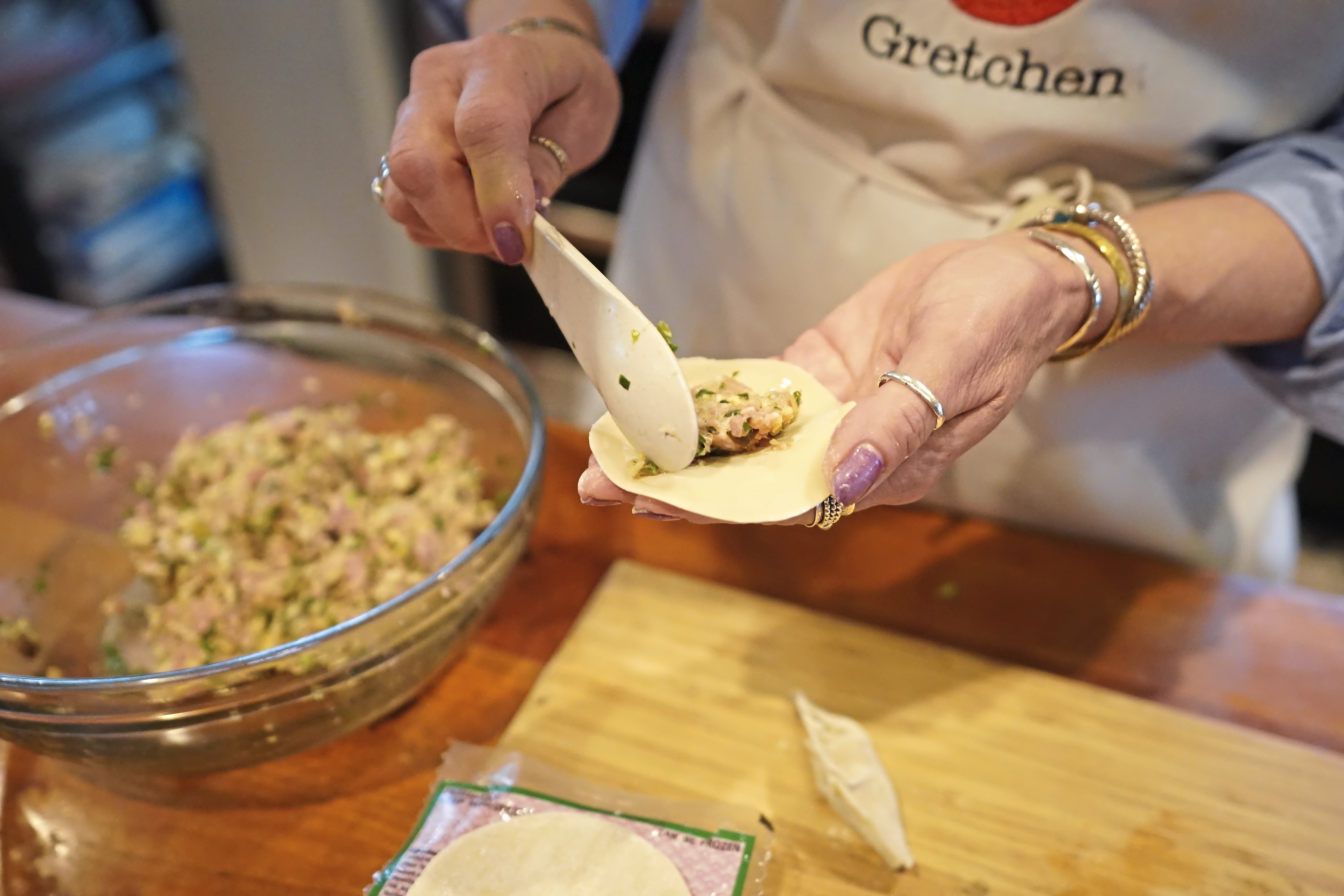
Dip your fingers in water and lightly wet one half of the wrapper’s rim. Fold the wrapper in half.
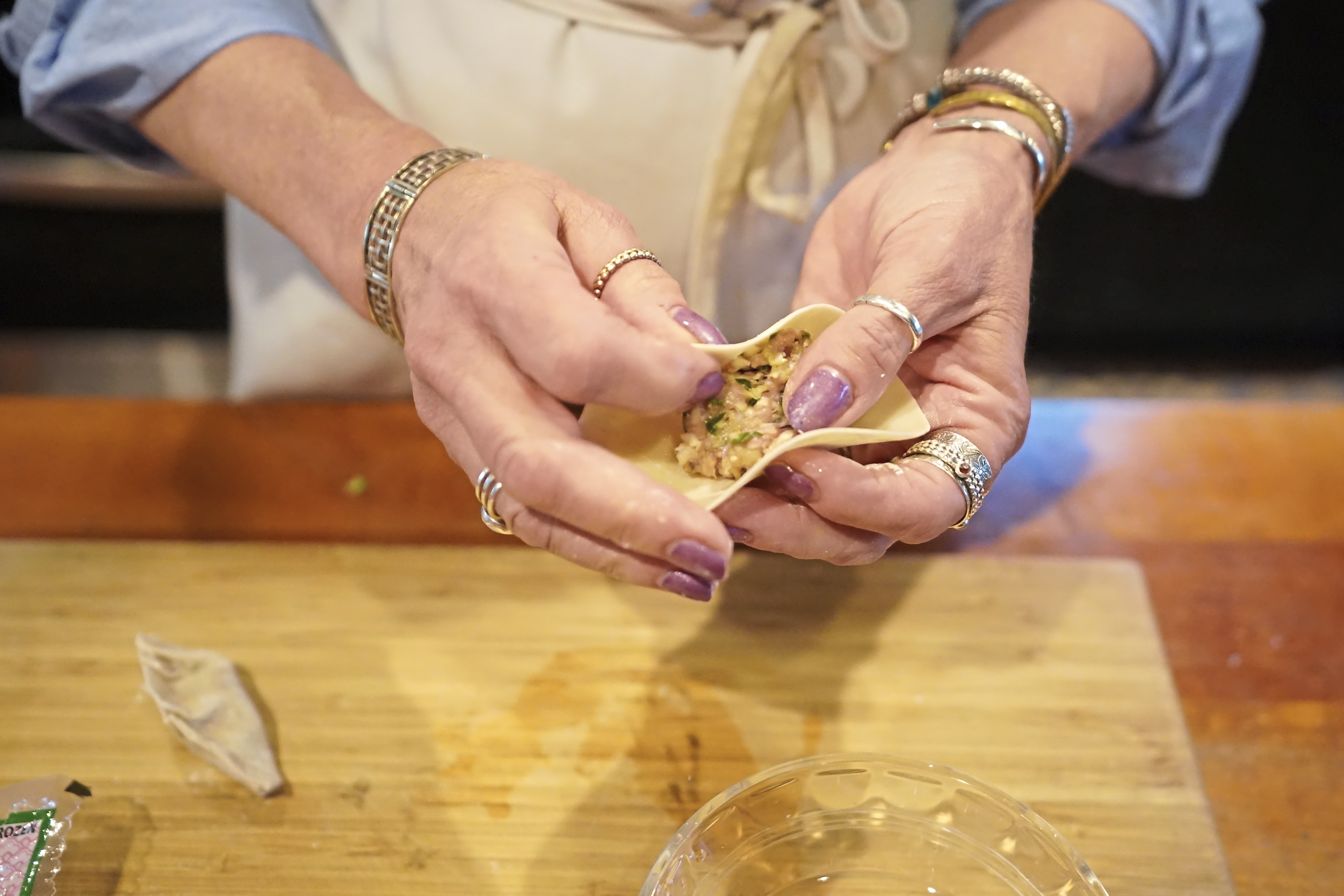
Using your fingertips, pleat only the top half of the wrapper, pressing against the bottom half to seal the gyoza. (The bottom half of the wrapper remains flat; you only fold one side of the wrapper.)
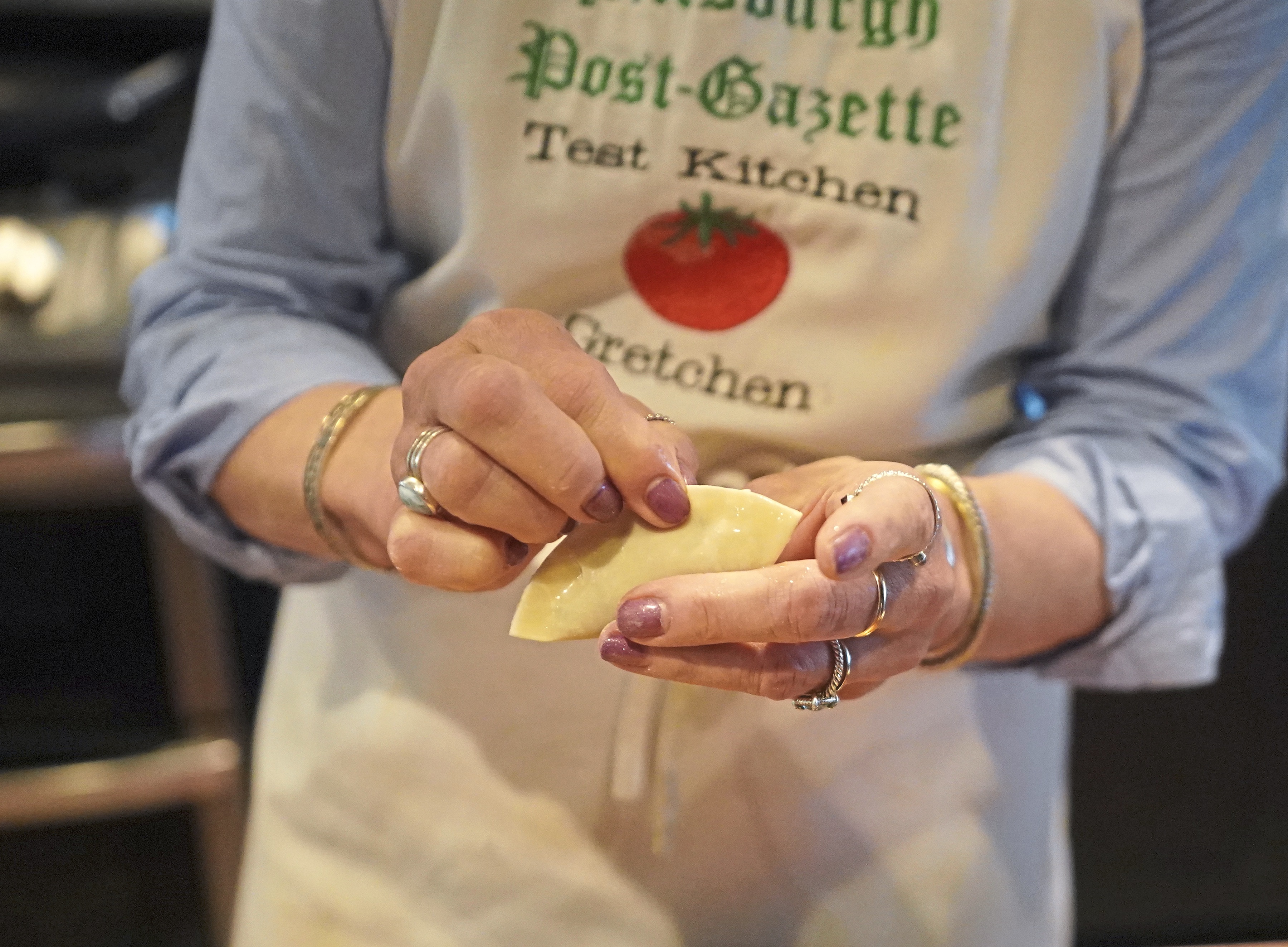
Place gyoza on the prepared baking sheet. Repeat with the remaining wrappers and filling. Sprinkle with more cornstarch if the gyoza seem to be sticking together. Uncooked gyoza will keep in the freezer in a resealable plastic freezer bag for up to 3 months.
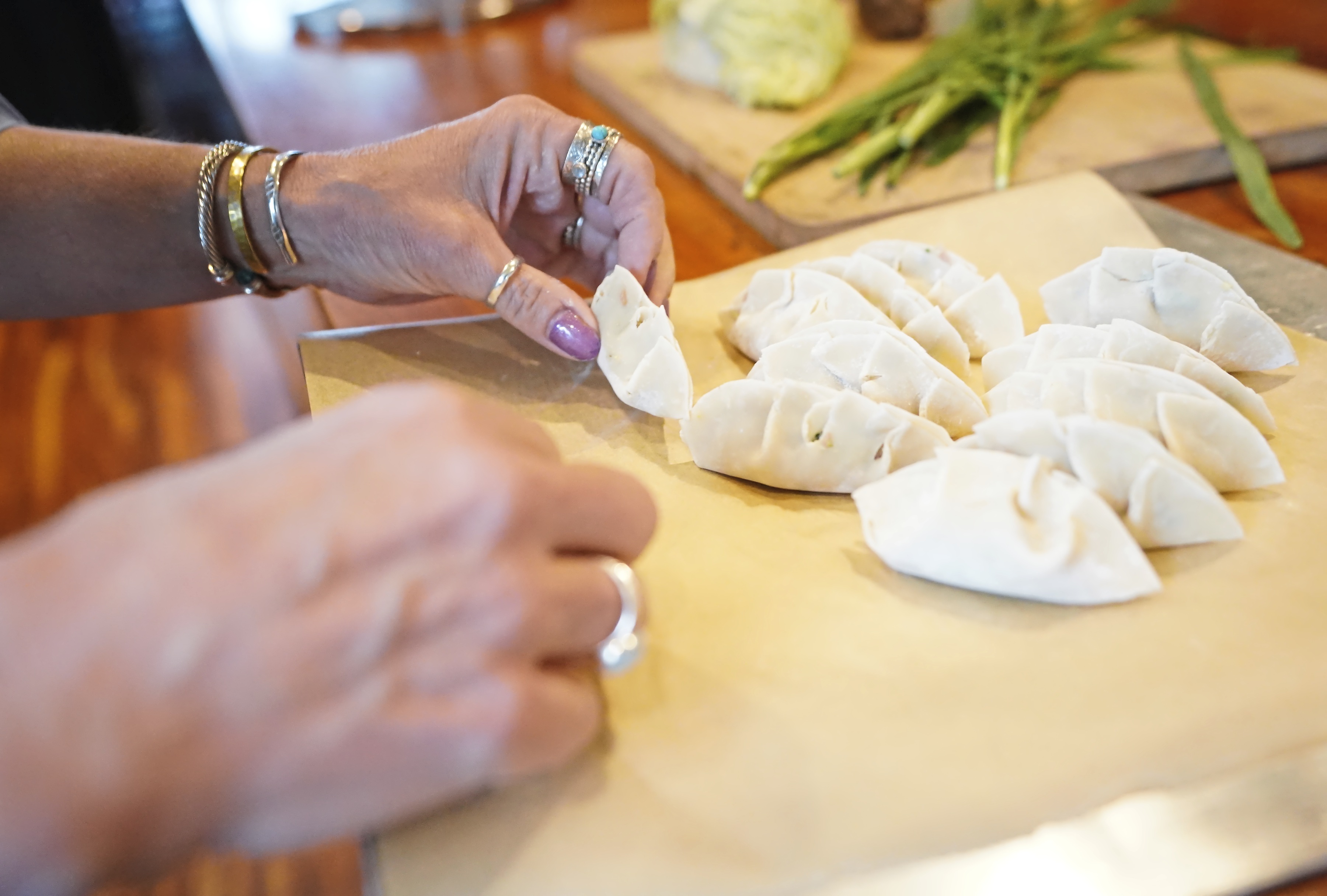
In a 10-inch nonstick skillet with a lid, heat 2 teaspoons neutral oil over medium heat. Add enough gyoza to fit in a single layer (about 12), arranging them in a circular pattern.
Cook until slightly golden on the bottoms, 1 to 3 minutes.
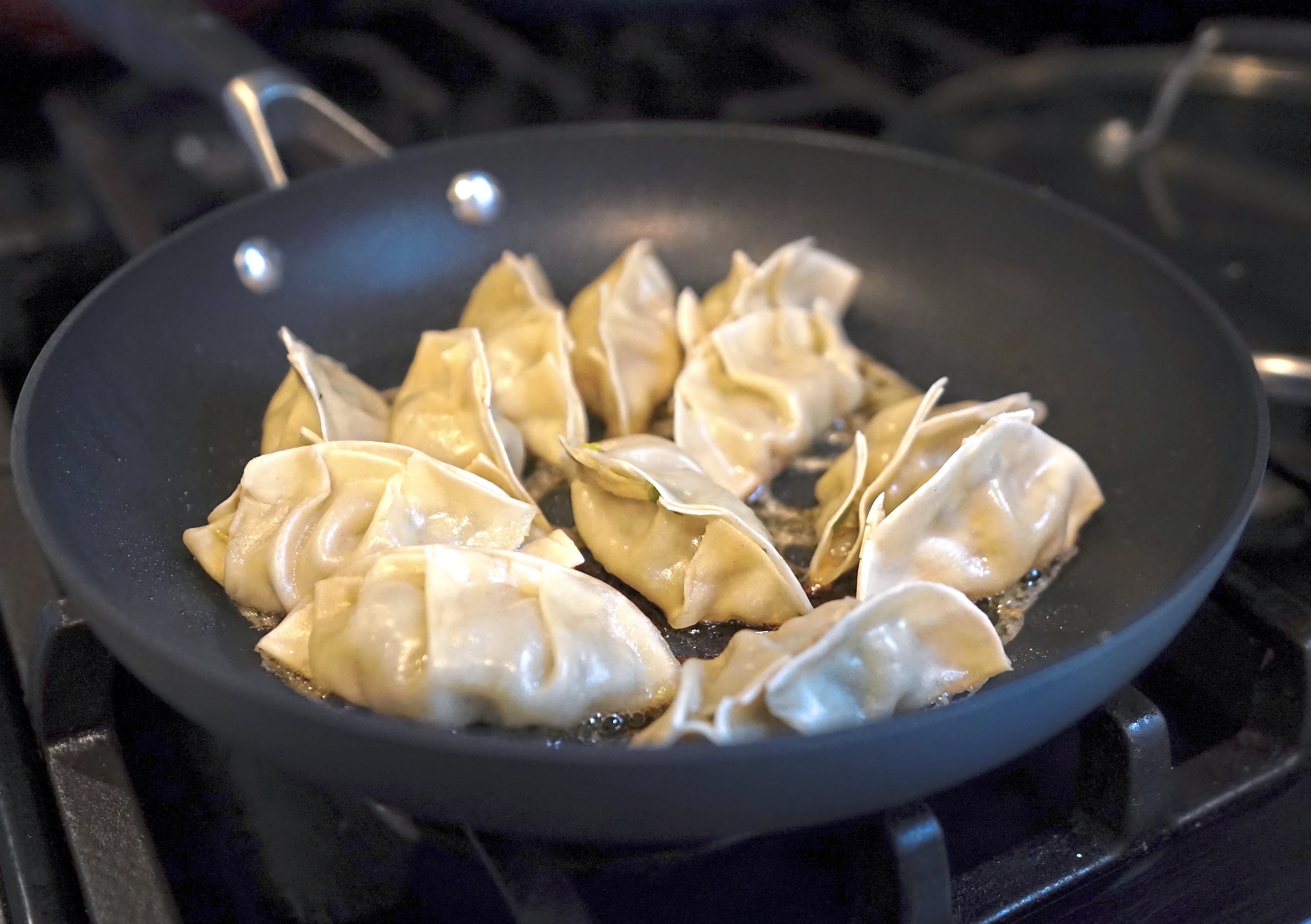
In a small bowl or measuring cup, combine ⅓ cup water, 1½ teaspoons cornstarch and a pinch of salt. Pour the cornstarch mixture into the skillet.

Cover with lid and steam the gyoza until most of the water has evaporated, 6 to 8 minutes.
Uncover and continue cooking until the water has completely evaporated and the cornstarch has thickened to a gel-like web at the bottom of the skillet, about 2 minutes.
Drizzle some sesame oil around the edges of the gyoza. Increase the heat to medium-high and cook, uncovered, until the cornstarch dissolves and dries, forming “wings” that are lacy and crispy, 2 to 4 minutes. Remove skillet from heat and let the gyoza rest in the skillet until any bubbling subsides, 1 to 2 minutes.
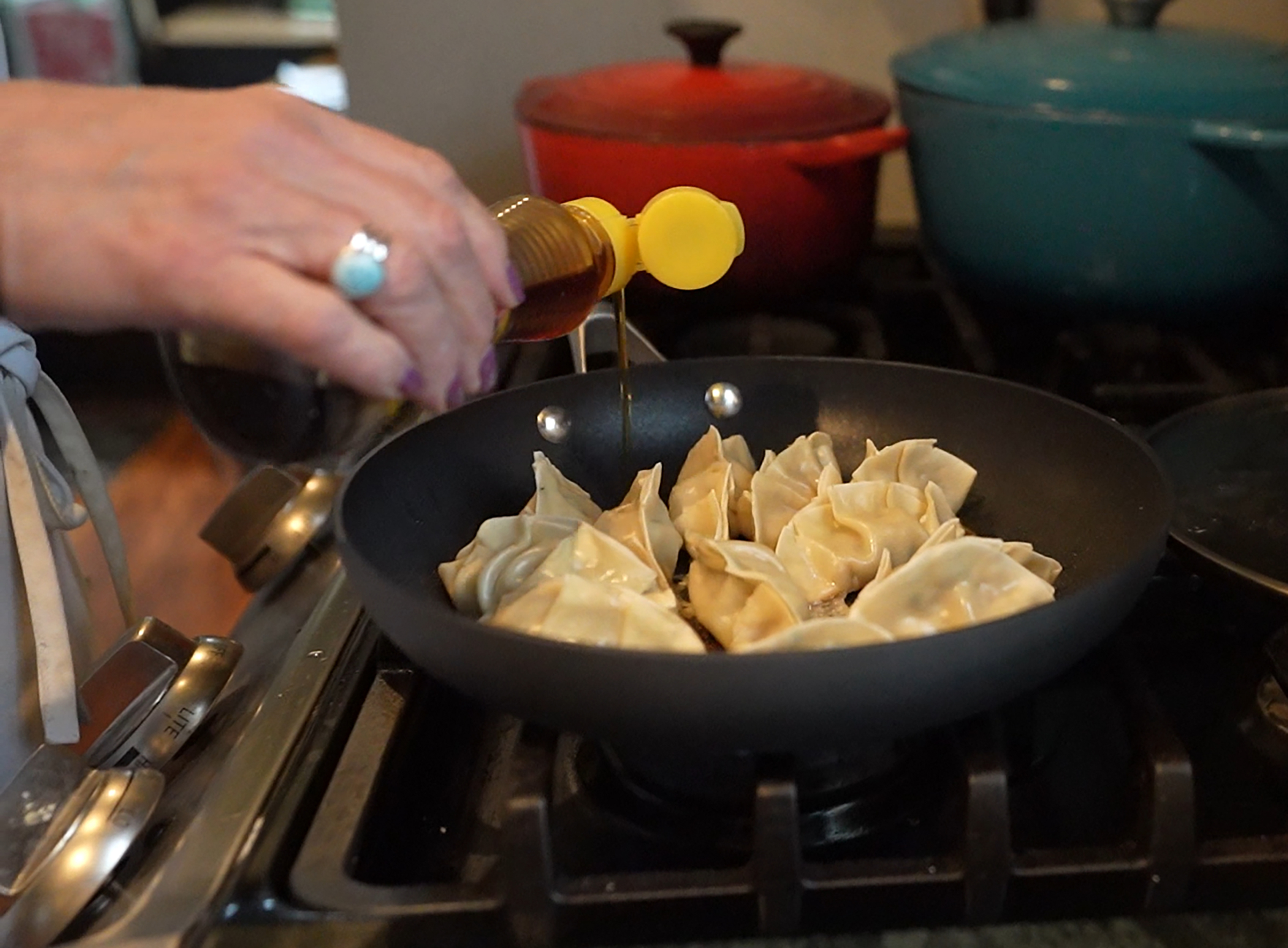
Using chopsticks or a spatula, loosen the “wings.” Place a large plate on top of the gyoza. Flip the skillet upside down to invert the gyoza onto the plate. Wipe the skillet clean and repeat with remaining gyoza.

Serve hot with dipping sauce.
Serves 6-8.
— “Make it Japanese: Simple Recipes for Everyone” by Rie McClenny (Clarkson Potter, Oct. 2023, $30)
Gretchen McKay: gmckay@post-gazette.com.
Hal B. Klein
Gretchen McKay
Sebastian Foltz
Benjamin B. Braun
Hal B. Klein
James Hilston
Laura Malt Schneiderman
Ed Yozwick
Advertisement
Advertisement